Higher Nationals in Computing.
VerifiedAdded on 2023/01/17
|37
|6860
|51
AI Summary
Contribute Materials
Your contribution can guide someone’s learning journey. Share your
documents today.
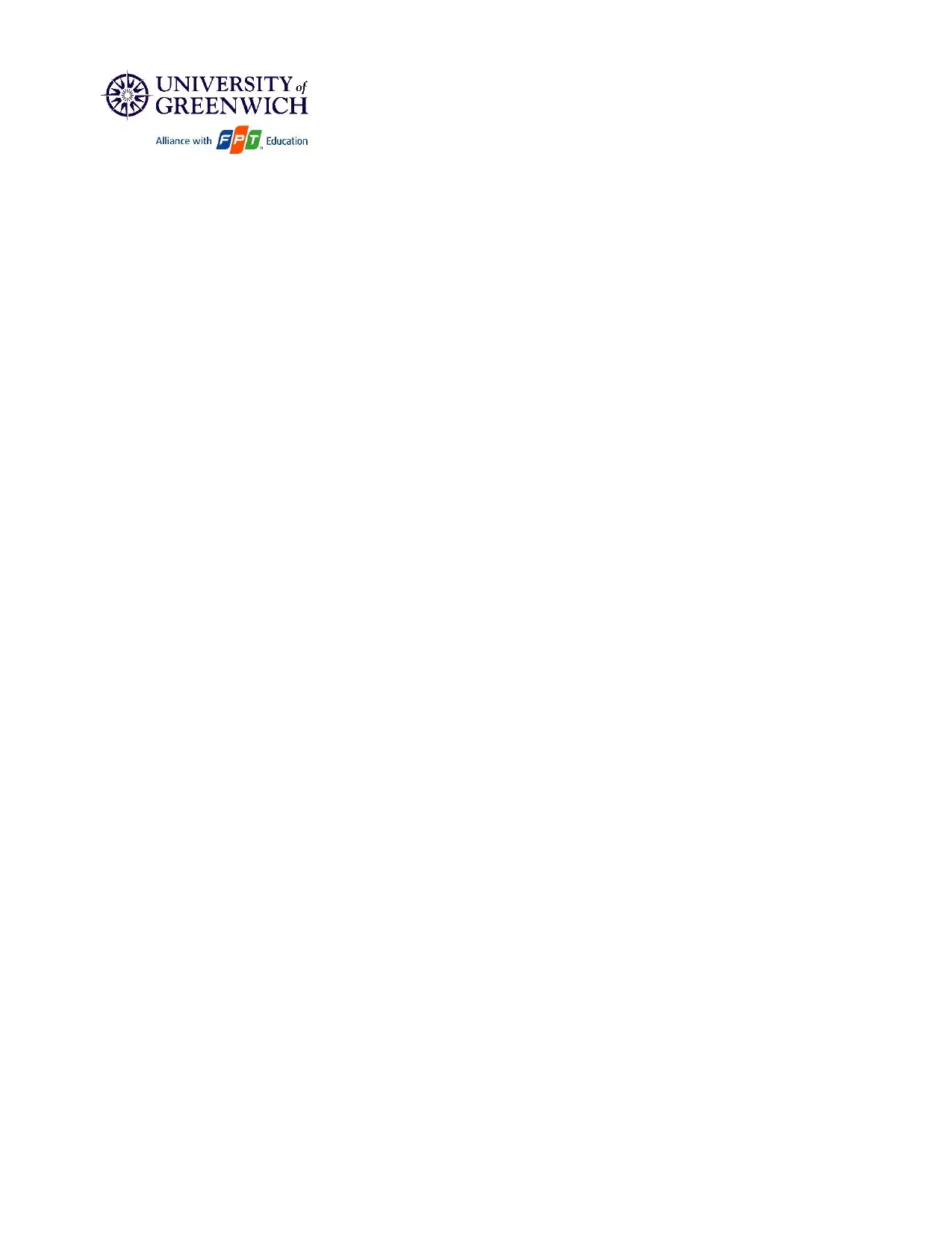
Secure Best Marks with AI Grader
Need help grading? Try our AI Grader for instant feedback on your assignments.
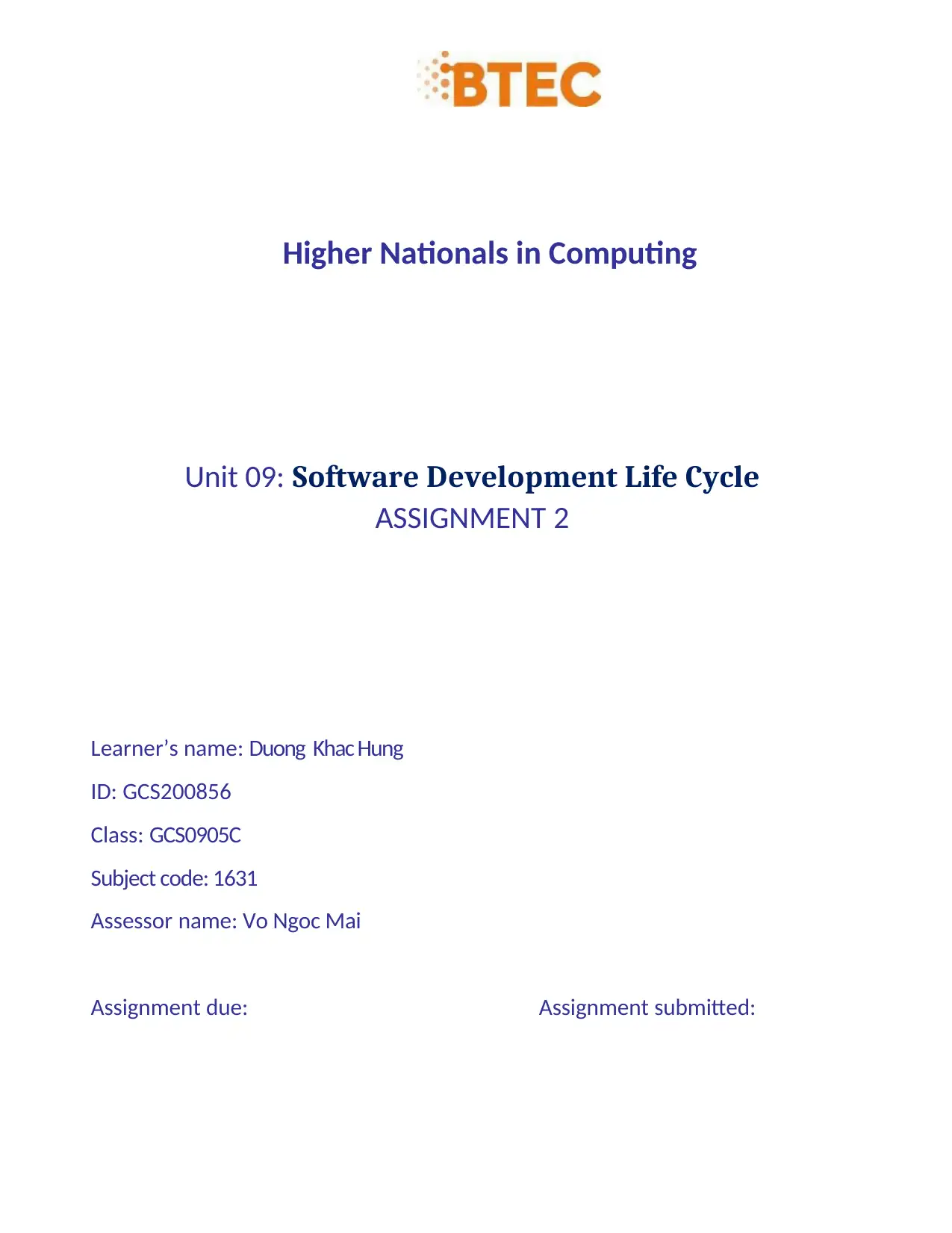
Higher Nationals in Computing
Unit 09: Software Development Life Cycle
ASSIGNMENT 2
Learner’s name: Duong Khac Hung
ID: GCS200856
Class: GCS0905C
Subject code: 1631
Assessor name: Vo Ngoc Mai
Assignment due: Assignment submitted:
Unit 09: Software Development Life Cycle
ASSIGNMENT 2
Learner’s name: Duong Khac Hung
ID: GCS200856
Class: GCS0905C
Subject code: 1631
Assessor name: Vo Ngoc Mai
Assignment due: Assignment submitted:
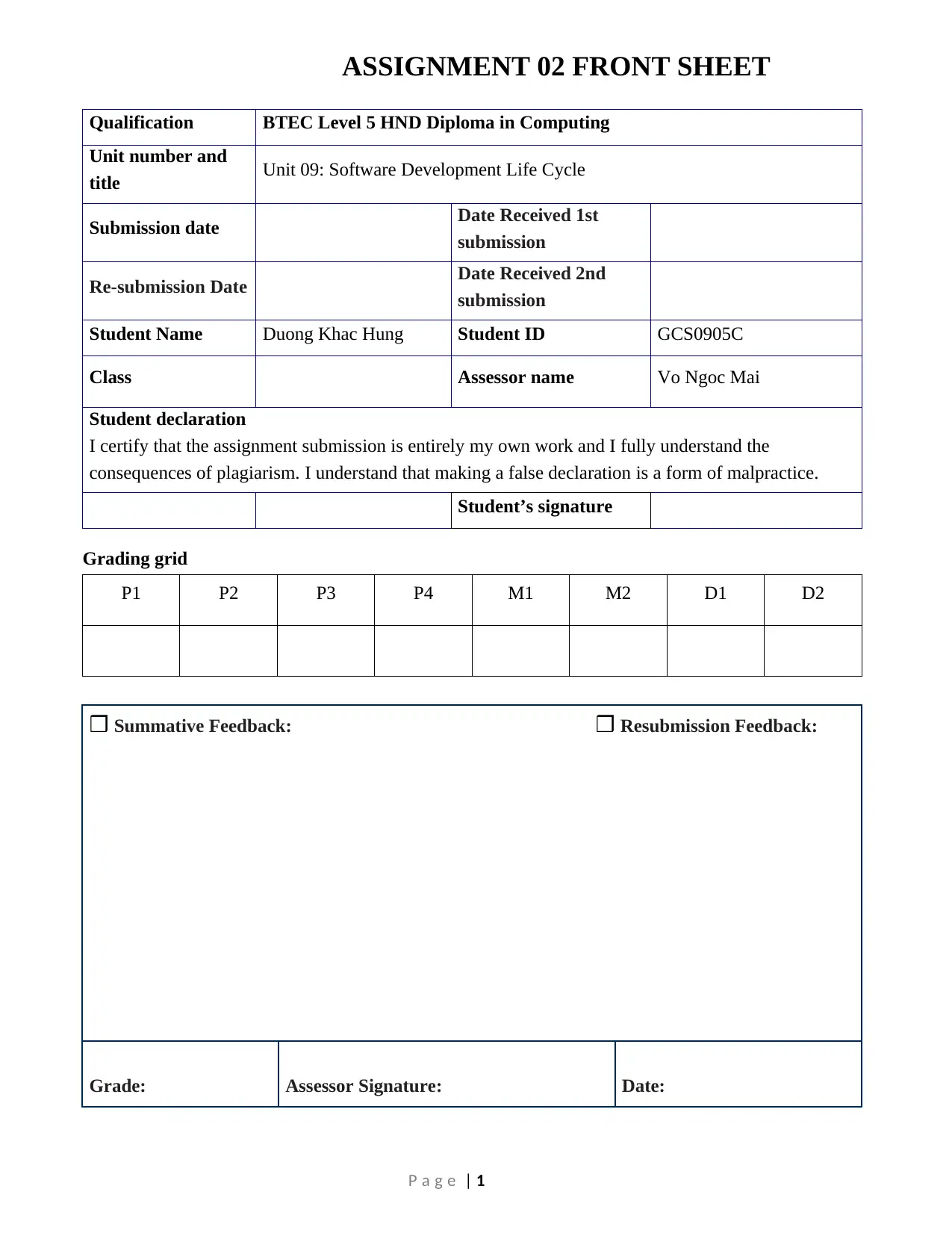
ASSIGNMENT 02 FRONT SHEET
Qualification BTEC Level 5 HND Diploma in Computing
Unit number and
title Unit 09: Software Development Life Cycle
Submission date Date Received 1st
submission
Re-submission Date Date Received 2nd
submission
Student Name Duong Khac Hung Student ID GCS0905C
Class Assessor name Vo Ngoc Mai
Student declaration
I certify that the assignment submission is entirely my own work and I fully understand the
consequences of plagiarism. I understand that making a false declaration is a form of malpractice.
Student’s signature
Grading grid
P1 P2 P3 P4 M1 M2 D1 D2
❒ Summative Feedback: ❒ Resubmission Feedback:
Grade: Assessor Signature: Date:
P a g e | 1
Qualification BTEC Level 5 HND Diploma in Computing
Unit number and
title Unit 09: Software Development Life Cycle
Submission date Date Received 1st
submission
Re-submission Date Date Received 2nd
submission
Student Name Duong Khac Hung Student ID GCS0905C
Class Assessor name Vo Ngoc Mai
Student declaration
I certify that the assignment submission is entirely my own work and I fully understand the
consequences of plagiarism. I understand that making a false declaration is a form of malpractice.
Student’s signature
Grading grid
P1 P2 P3 P4 M1 M2 D1 D2
❒ Summative Feedback: ❒ Resubmission Feedback:
Grade: Assessor Signature: Date:
P a g e | 1
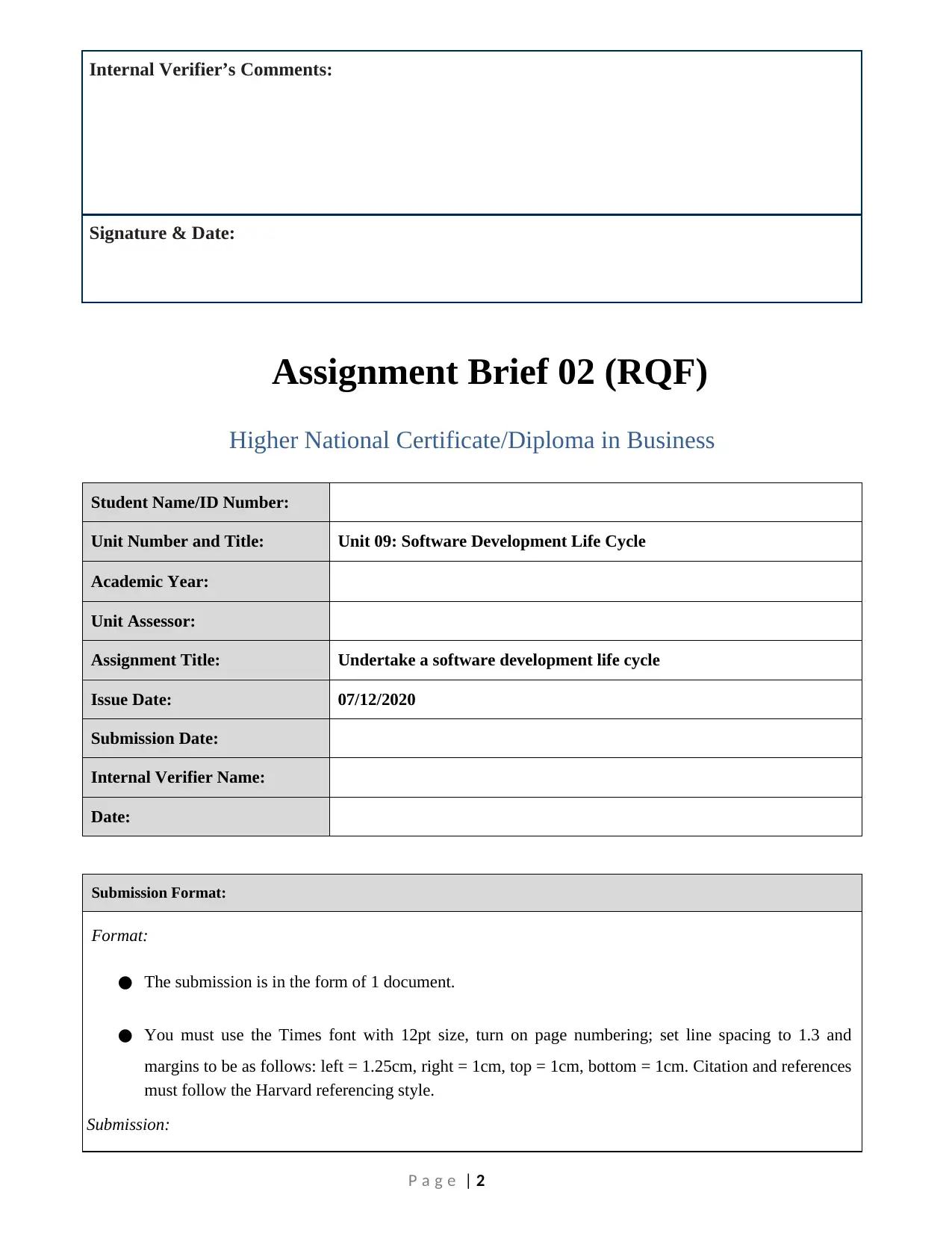
Internal Verifier’s Comments:
Signature & Date:
Assignment Brief 02 (RQF)
Higher National Certificate/Diploma in Business
Student Name/ID Number:
Unit Number and Title: Unit 09: Software Development Life Cycle
Academic Year:
Unit Assessor:
Assignment Title: Undertake a software development life cycle
Issue Date: 07/12/2020
Submission Date:
Internal Verifier Name:
Date:
Submission Format:
Format:
● The submission is in the form of 1 document.
● You must use the Times font with 12pt size, turn on page numbering; set line spacing to 1.3 and
margins to be as follows: left = 1.25cm, right = 1cm, top = 1cm, bottom = 1cm. Citation and references
must follow the Harvard referencing style.
Submission:
P a g e | 2
Signature & Date:
Assignment Brief 02 (RQF)
Higher National Certificate/Diploma in Business
Student Name/ID Number:
Unit Number and Title: Unit 09: Software Development Life Cycle
Academic Year:
Unit Assessor:
Assignment Title: Undertake a software development life cycle
Issue Date: 07/12/2020
Submission Date:
Internal Verifier Name:
Date:
Submission Format:
Format:
● The submission is in the form of 1 document.
● You must use the Times font with 12pt size, turn on page numbering; set line spacing to 1.3 and
margins to be as follows: left = 1.25cm, right = 1cm, top = 1cm, bottom = 1cm. Citation and references
must follow the Harvard referencing style.
Submission:
P a g e | 2
Secure Best Marks with AI Grader
Need help grading? Try our AI Grader for instant feedback on your assignments.
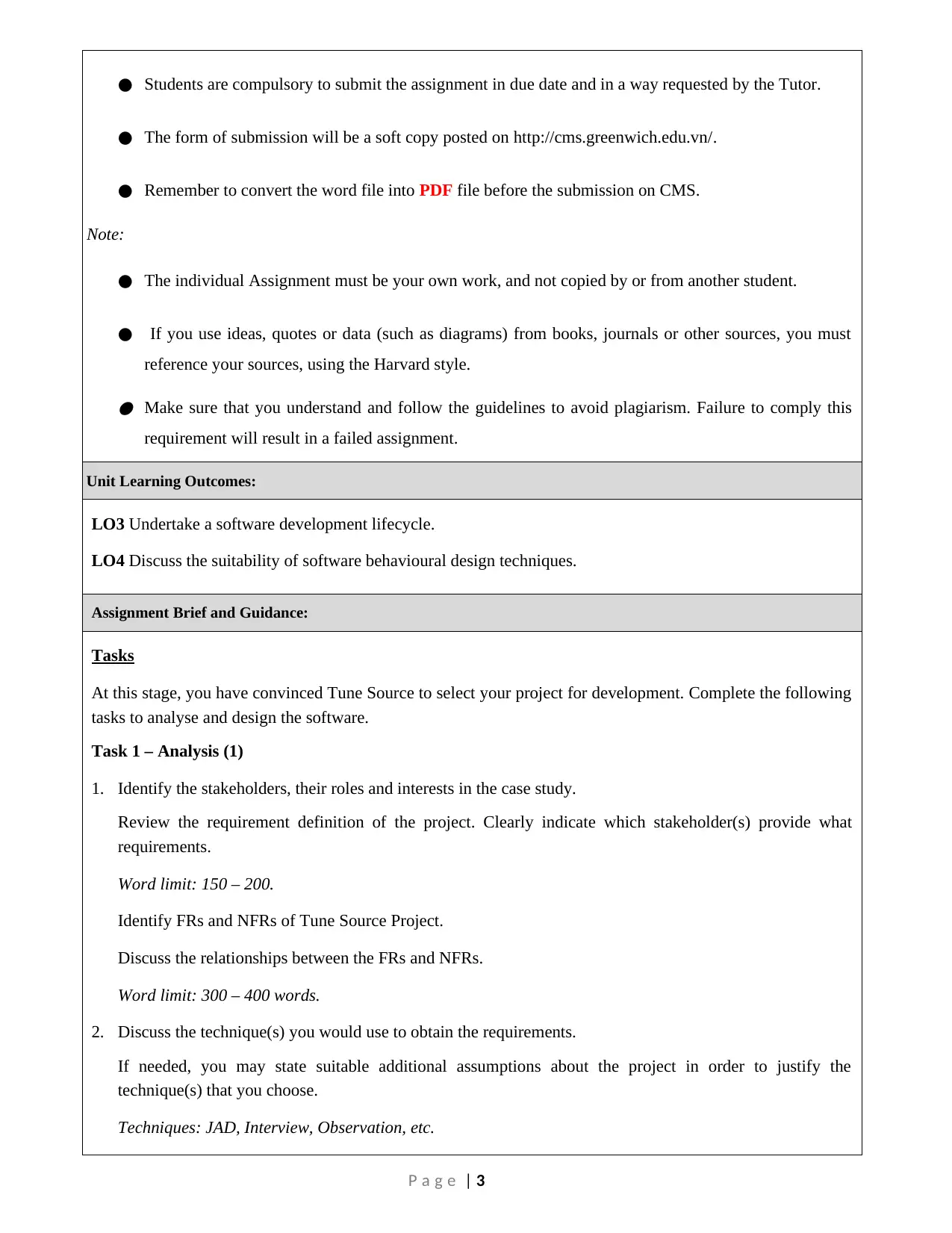
● Students are compulsory to submit the assignment in due date and in a way requested by the Tutor.
● The form of submission will be a soft copy posted on http://cms.greenwich.edu.vn/.
● Remember to convert the word file into PDF file before the submission on CMS.
Note:
● The individual Assignment must be your own work, and not copied by or from another student.
● If you use ideas, quotes or data (such as diagrams) from books, journals or other sources, you must
reference your sources, using the Harvard style.
● Make sure that you understand and follow the guidelines to avoid plagiarism. Failure to comply this
requirement will result in a failed assignment.
Unit Learning Outcomes:
LO3 Undertake a software development lifecycle.
LO4 Discuss the suitability of software behavioural design techniques.
Assignment Brief and Guidance:
Tasks
At this stage, you have convinced Tune Source to select your project for development. Complete the following
tasks to analyse and design the software.
Task 1 – Analysis (1)
1. Identify the stakeholders, their roles and interests in the case study.
Review the requirement definition of the project. Clearly indicate which stakeholder(s) provide what
requirements.
Word limit: 150 – 200.
Identify FRs and NFRs of Tune Source Project.
Discuss the relationships between the FRs and NFRs.
Word limit: 300 – 400 words.
2. Discuss the technique(s) you would use to obtain the requirements.
If needed, you may state suitable additional assumptions about the project in order to justify the
technique(s) that you choose.
Techniques: JAD, Interview, Observation, etc.
P a g e | 3
● The form of submission will be a soft copy posted on http://cms.greenwich.edu.vn/.
● Remember to convert the word file into PDF file before the submission on CMS.
Note:
● The individual Assignment must be your own work, and not copied by or from another student.
● If you use ideas, quotes or data (such as diagrams) from books, journals or other sources, you must
reference your sources, using the Harvard style.
● Make sure that you understand and follow the guidelines to avoid plagiarism. Failure to comply this
requirement will result in a failed assignment.
Unit Learning Outcomes:
LO3 Undertake a software development lifecycle.
LO4 Discuss the suitability of software behavioural design techniques.
Assignment Brief and Guidance:
Tasks
At this stage, you have convinced Tune Source to select your project for development. Complete the following
tasks to analyse and design the software.
Task 1 – Analysis (1)
1. Identify the stakeholders, their roles and interests in the case study.
Review the requirement definition of the project. Clearly indicate which stakeholder(s) provide what
requirements.
Word limit: 150 – 200.
Identify FRs and NFRs of Tune Source Project.
Discuss the relationships between the FRs and NFRs.
Word limit: 300 – 400 words.
2. Discuss the technique(s) you would use to obtain the requirements.
If needed, you may state suitable additional assumptions about the project in order to justify the
technique(s) that you choose.
Techniques: JAD, Interview, Observation, etc.
P a g e | 3
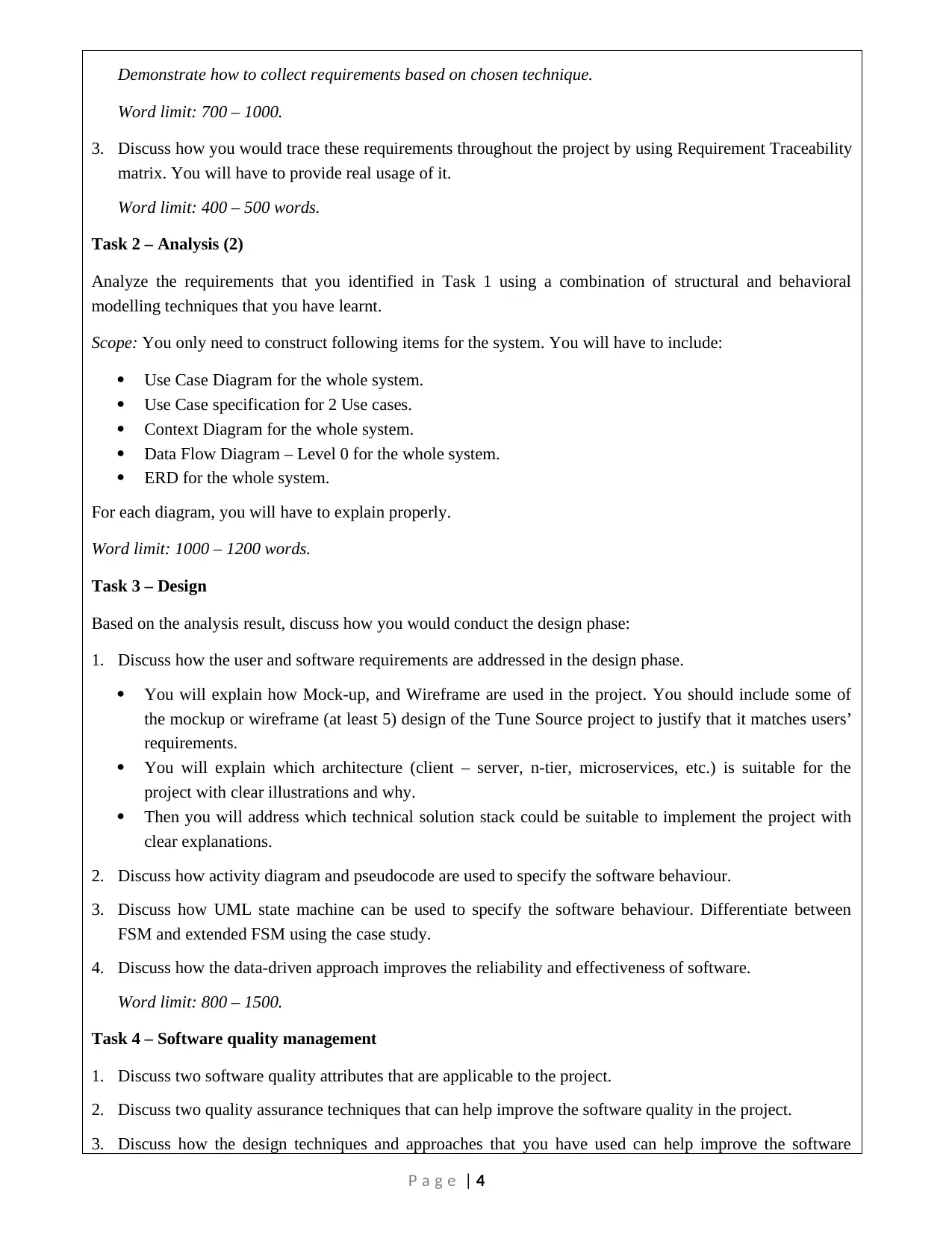
Demonstrate how to collect requirements based on chosen technique.
Word limit: 700 – 1000.
3. Discuss how you would trace these requirements throughout the project by using Requirement Traceability
matrix. You will have to provide real usage of it.
Word limit: 400 – 500 words.
Task 2 – Analysis (2)
Analyze the requirements that you identified in Task 1 using a combination of structural and behavioral
modelling techniques that you have learnt.
Scope: You only need to construct following items for the system. You will have to include:
Use Case Diagram for the whole system.
Use Case specification for 2 Use cases.
Context Diagram for the whole system.
Data Flow Diagram – Level 0 for the whole system.
ERD for the whole system.
For each diagram, you will have to explain properly.
Word limit: 1000 – 1200 words.
Task 3 – Design
Based on the analysis result, discuss how you would conduct the design phase:
1. Discuss how the user and software requirements are addressed in the design phase.
You will explain how Mock-up, and Wireframe are used in the project. You should include some of
the mockup or wireframe (at least 5) design of the Tune Source project to justify that it matches users’
requirements.
You will explain which architecture (client – server, n-tier, microservices, etc.) is suitable for the
project with clear illustrations and why.
Then you will address which technical solution stack could be suitable to implement the project with
clear explanations.
2. Discuss how activity diagram and pseudocode are used to specify the software behaviour.
3. Discuss how UML state machine can be used to specify the software behaviour. Differentiate between
FSM and extended FSM using the case study.
4. Discuss how the data-driven approach improves the reliability and effectiveness of software.
Word limit: 800 – 1500.
Task 4 – Software quality management
1. Discuss two software quality attributes that are applicable to the project.
2. Discuss two quality assurance techniques that can help improve the software quality in the project.
3. Discuss how the design techniques and approaches that you have used can help improve the software
P a g e | 4
Word limit: 700 – 1000.
3. Discuss how you would trace these requirements throughout the project by using Requirement Traceability
matrix. You will have to provide real usage of it.
Word limit: 400 – 500 words.
Task 2 – Analysis (2)
Analyze the requirements that you identified in Task 1 using a combination of structural and behavioral
modelling techniques that you have learnt.
Scope: You only need to construct following items for the system. You will have to include:
Use Case Diagram for the whole system.
Use Case specification for 2 Use cases.
Context Diagram for the whole system.
Data Flow Diagram – Level 0 for the whole system.
ERD for the whole system.
For each diagram, you will have to explain properly.
Word limit: 1000 – 1200 words.
Task 3 – Design
Based on the analysis result, discuss how you would conduct the design phase:
1. Discuss how the user and software requirements are addressed in the design phase.
You will explain how Mock-up, and Wireframe are used in the project. You should include some of
the mockup or wireframe (at least 5) design of the Tune Source project to justify that it matches users’
requirements.
You will explain which architecture (client – server, n-tier, microservices, etc.) is suitable for the
project with clear illustrations and why.
Then you will address which technical solution stack could be suitable to implement the project with
clear explanations.
2. Discuss how activity diagram and pseudocode are used to specify the software behaviour.
3. Discuss how UML state machine can be used to specify the software behaviour. Differentiate between
FSM and extended FSM using the case study.
4. Discuss how the data-driven approach improves the reliability and effectiveness of software.
Word limit: 800 – 1500.
Task 4 – Software quality management
1. Discuss two software quality attributes that are applicable to the project.
2. Discuss two quality assurance techniques that can help improve the software quality in the project.
3. Discuss how the design techniques and approaches that you have used can help improve the software
P a g e | 4
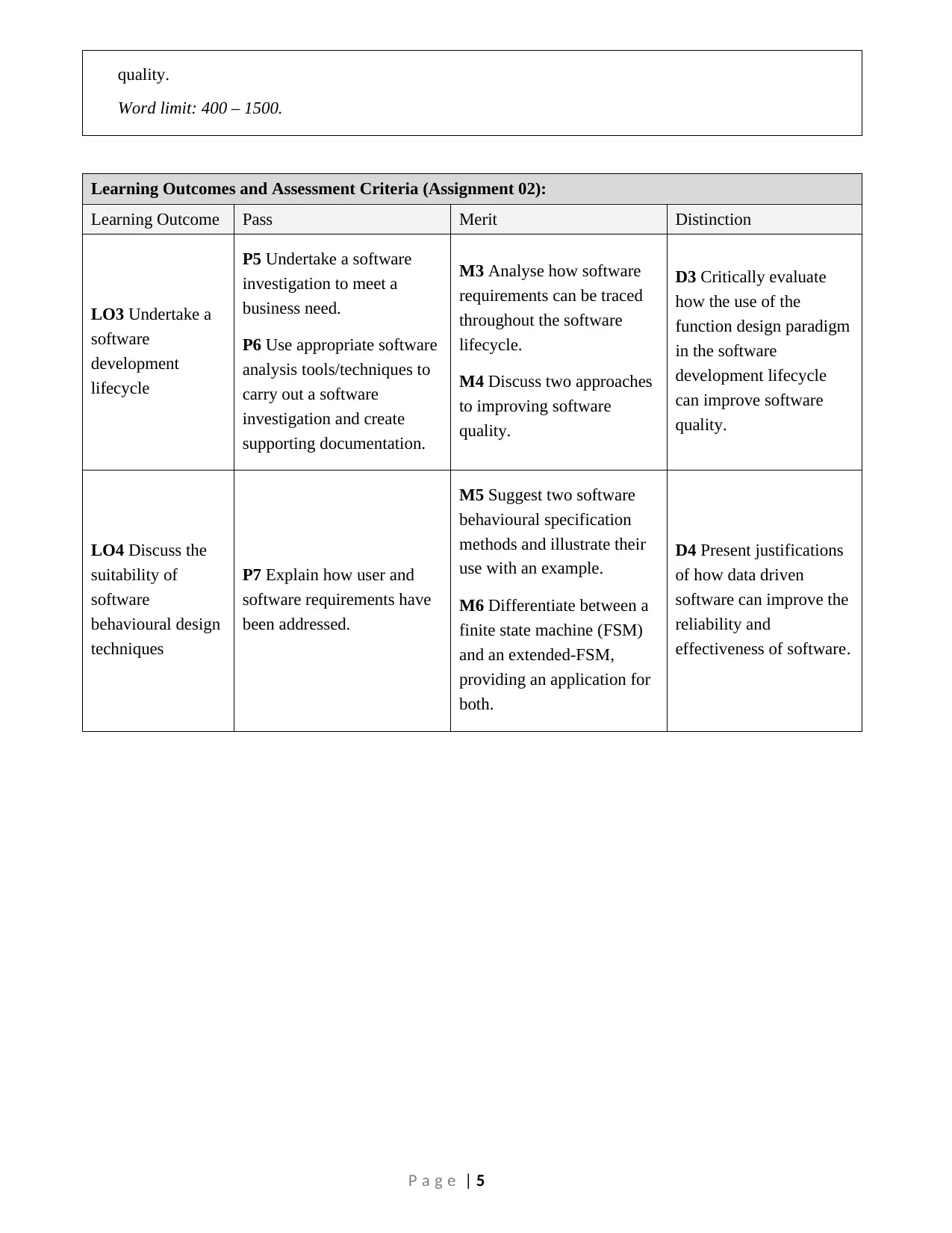
quality.
Word limit: 400 – 1500.
Learning Outcomes and Assessment Criteria (Assignment 02):
Learning Outcome Pass Merit Distinction
LO3 Undertake a
software
development
lifecycle
P5 Undertake a software
investigation to meet a
business need.
P6 Use appropriate software
analysis tools/techniques to
carry out a software
investigation and create
supporting documentation.
M3 Analyse how software
requirements can be traced
throughout the software
lifecycle.
M4 Discuss two approaches
to improving software
quality.
D3 Critically evaluate
how the use of the
function design paradigm
in the software
development lifecycle
can improve software
quality.
LO4 Discuss the
suitability of
software
behavioural design
techniques
P7 Explain how user and
software requirements have
been addressed.
M5 Suggest two software
behavioural specification
methods and illustrate their
use with an example.
M6 Differentiate between a
finite state machine (FSM)
and an extended-FSM,
providing an application for
both.
D4 Present justifications
of how data driven
software can improve the
reliability and
effectiveness of software.
P a g e | 5
Word limit: 400 – 1500.
Learning Outcomes and Assessment Criteria (Assignment 02):
Learning Outcome Pass Merit Distinction
LO3 Undertake a
software
development
lifecycle
P5 Undertake a software
investigation to meet a
business need.
P6 Use appropriate software
analysis tools/techniques to
carry out a software
investigation and create
supporting documentation.
M3 Analyse how software
requirements can be traced
throughout the software
lifecycle.
M4 Discuss two approaches
to improving software
quality.
D3 Critically evaluate
how the use of the
function design paradigm
in the software
development lifecycle
can improve software
quality.
LO4 Discuss the
suitability of
software
behavioural design
techniques
P7 Explain how user and
software requirements have
been addressed.
M5 Suggest two software
behavioural specification
methods and illustrate their
use with an example.
M6 Differentiate between a
finite state machine (FSM)
and an extended-FSM,
providing an application for
both.
D4 Present justifications
of how data driven
software can improve the
reliability and
effectiveness of software.
P a g e | 5
Paraphrase This Document
Need a fresh take? Get an instant paraphrase of this document with our AI Paraphraser

Table of Contents
Assignment Brief 02 (RQF)....................................................................................................................................2
Higher National Certificate/Diploma in Business................................................................................................2
P5 Undertake a software investigation to meet a business need............................................................................8
1. Identify the stakeholders, their roles and interests in the case study.........................................................8
2.Review the requirement definition of the project. Clearly indicate which stakeholder(s) provide what
requirements.......................................................................................................................................................9
2.1 What Is Requirements Analysis?...............................................................................................................9
2.2 Types of requirements...............................................................................................................................9
3.Identify FRs and NFRs of Tune Source Project................................................................................................10
3.1 What is FRs (Functional requirements)?..................................................................................................10
3.2 What is NFRs (Non-Functional requirements)?.......................................................................................12
4. Discuss the relationships between the FRs and NFRs................................................................................14
5.Discuss the technique(s) you would use to obtain the requirements............................................................17
5.1What is Requirements Elicitation?............................................................................................................17
5.2 Interviews................................................................................................................................................18
5.3 Joint Application Development...............................................................................................................20
5.4 Questionnaires........................................................................................................................................22
5.5.................................................................................................................................................................24
5.6 Observation.............................................................................................................................................25
6. Apply to Tune Source................................................................................................................................27
P6 Use appropriate software analysis tools/techniques to carry out a software investigation and create
supporting documentation....................................................................................................................................28
1.Introduce about Requirement Modellings.....................................................................................................28
1.1 Definition.....................................................................................................................................................28
2. Apply to Tune Source................................................................................................................................29
2.1 ERD..........................................................................................................................................................29
2.2 DFD..........................................................................................................................................................30
2.3 Flowchart.................................................................................................................................................30
3 Pseudocode....................................................................................................................................................31
P7. Discuss how the user and software requirements are addressed in the design phase...................................32
1.Introduce about use case diagram.................................................................................................................32
1.1 Major UC diagram..............................................................................................................................33
2.Function UC diagram......................................................................................................................................33
P a g e | 6
Assignment Brief 02 (RQF)....................................................................................................................................2
Higher National Certificate/Diploma in Business................................................................................................2
P5 Undertake a software investigation to meet a business need............................................................................8
1. Identify the stakeholders, their roles and interests in the case study.........................................................8
2.Review the requirement definition of the project. Clearly indicate which stakeholder(s) provide what
requirements.......................................................................................................................................................9
2.1 What Is Requirements Analysis?...............................................................................................................9
2.2 Types of requirements...............................................................................................................................9
3.Identify FRs and NFRs of Tune Source Project................................................................................................10
3.1 What is FRs (Functional requirements)?..................................................................................................10
3.2 What is NFRs (Non-Functional requirements)?.......................................................................................12
4. Discuss the relationships between the FRs and NFRs................................................................................14
5.Discuss the technique(s) you would use to obtain the requirements............................................................17
5.1What is Requirements Elicitation?............................................................................................................17
5.2 Interviews................................................................................................................................................18
5.3 Joint Application Development...............................................................................................................20
5.4 Questionnaires........................................................................................................................................22
5.5.................................................................................................................................................................24
5.6 Observation.............................................................................................................................................25
6. Apply to Tune Source................................................................................................................................27
P6 Use appropriate software analysis tools/techniques to carry out a software investigation and create
supporting documentation....................................................................................................................................28
1.Introduce about Requirement Modellings.....................................................................................................28
1.1 Definition.....................................................................................................................................................28
2. Apply to Tune Source................................................................................................................................29
2.1 ERD..........................................................................................................................................................29
2.2 DFD..........................................................................................................................................................30
2.3 Flowchart.................................................................................................................................................30
3 Pseudocode....................................................................................................................................................31
P7. Discuss how the user and software requirements are addressed in the design phase...................................32
1.Introduce about use case diagram.................................................................................................................32
1.1 Major UC diagram..............................................................................................................................33
2.Function UC diagram......................................................................................................................................33
P a g e | 6
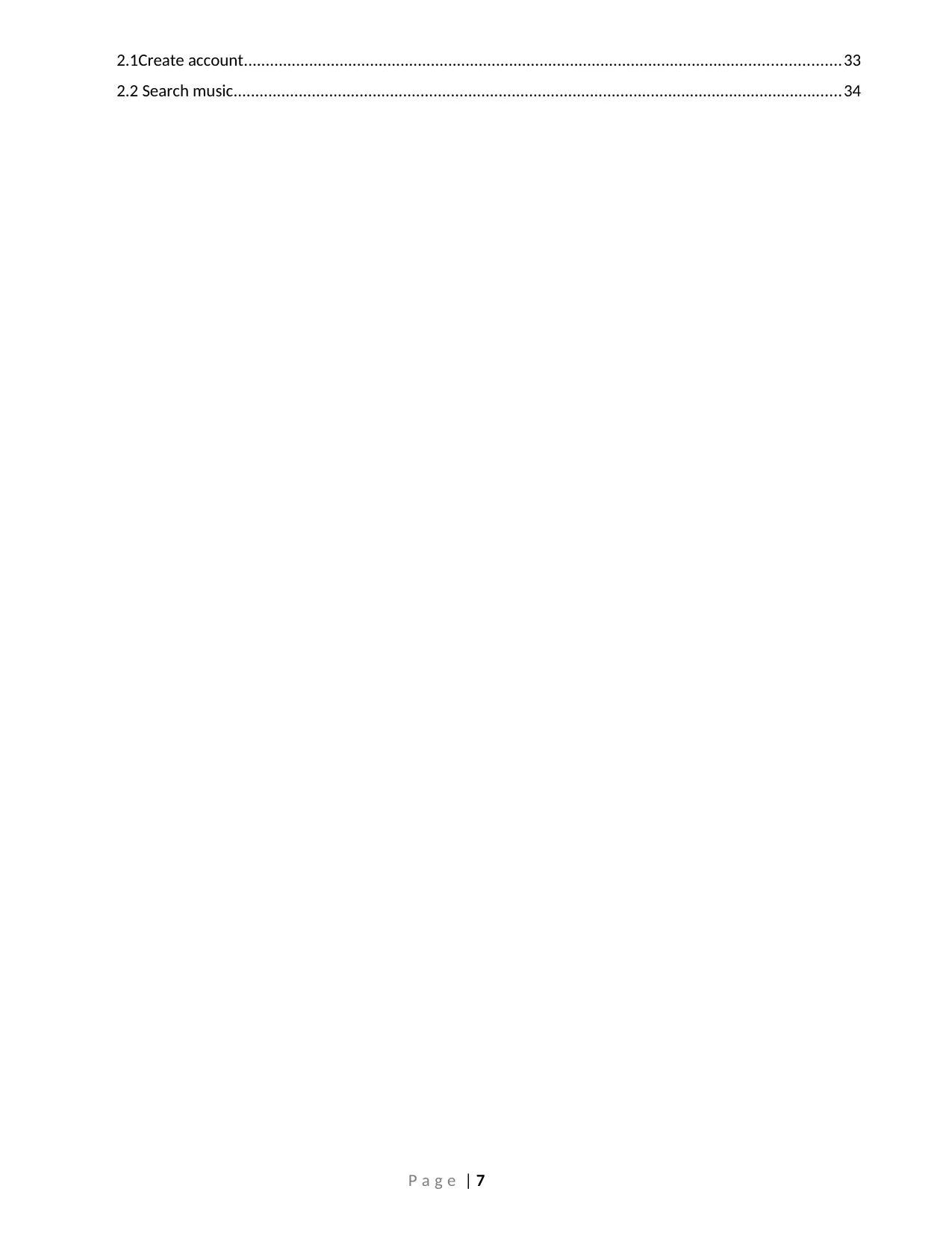
2.1Create account.........................................................................................................................................33
2.2 Search music............................................................................................................................................34
P a g e | 7
2.2 Search music............................................................................................................................................34
P a g e | 7
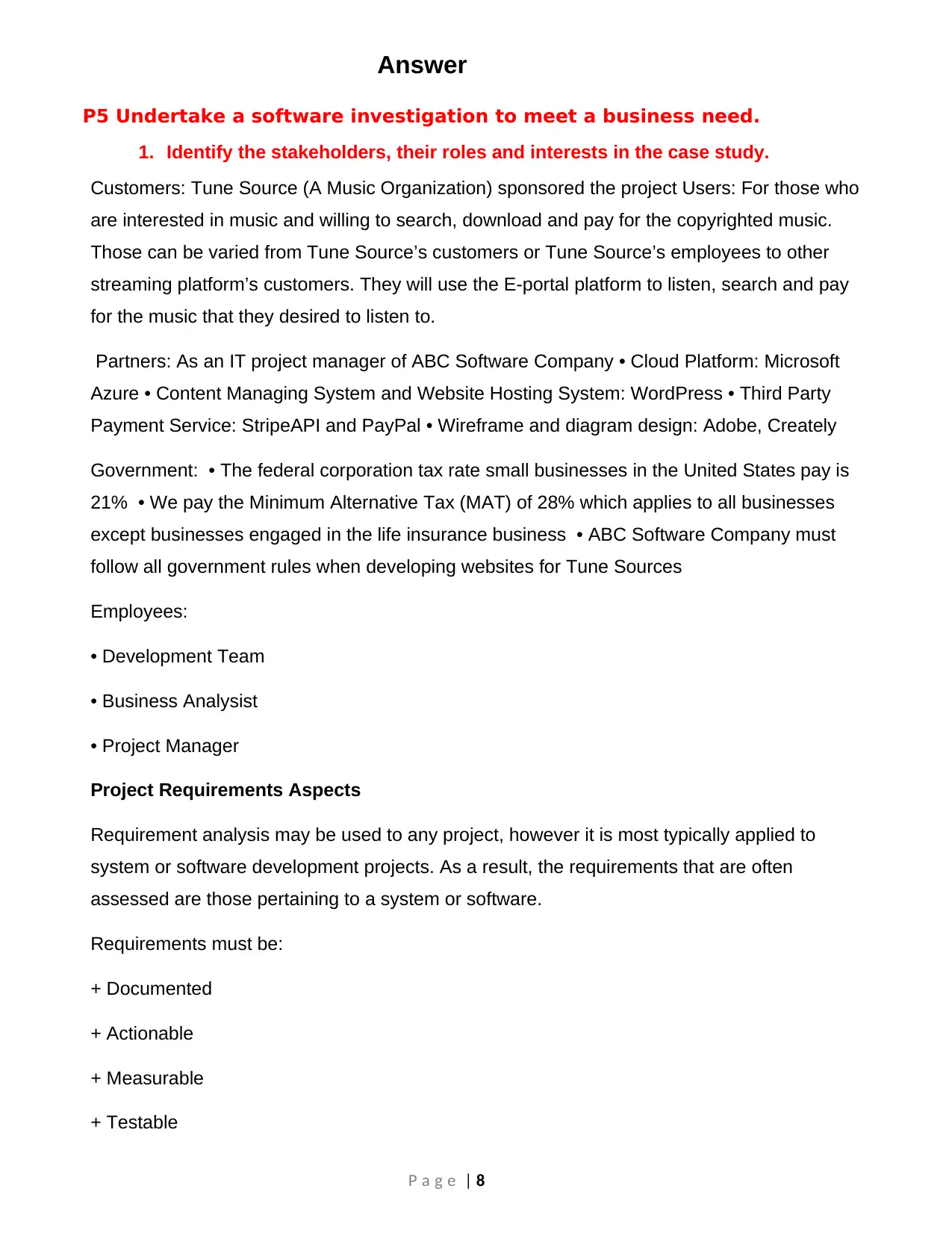
Answer
P5 Undertake a software investigation to meet a business need.
1. Identify the stakeholders, their roles and interests in the case study.
Customers: Tune Source (A Music Organization) sponsored the project Users: For those who
are interested in music and willing to search, download and pay for the copyrighted music.
Those can be varied from Tune Source’s customers or Tune Source’s employees to other
streaming platform’s customers. They will use the E-portal platform to listen, search and pay
for the music that they desired to listen to.
Partners: As an IT project manager of ABC Software Company • Cloud Platform: Microsoft
Azure • Content Managing System and Website Hosting System: WordPress • Third Party
Payment Service: StripeAPI and PayPal • Wireframe and diagram design: Adobe, Creately
Government: • The federal corporation tax rate small businesses in the United States pay is
21% • We pay the Minimum Alternative Tax (MAT) of 28% which applies to all businesses
except businesses engaged in the life insurance business • ABC Software Company must
follow all government rules when developing websites for Tune Sources
Employees:
• Development Team
• Business Analysist
• Project Manager
Project Requirements Aspects
Requirement analysis may be used to any project, however it is most typically applied to
system or software development projects. As a result, the requirements that are often
assessed are those pertaining to a system or software.
Requirements must be:
+ Documented
+ Actionable
+ Measurable
+ Testable
P a g e | 8
P5 Undertake a software investigation to meet a business need.
1. Identify the stakeholders, their roles and interests in the case study.
Customers: Tune Source (A Music Organization) sponsored the project Users: For those who
are interested in music and willing to search, download and pay for the copyrighted music.
Those can be varied from Tune Source’s customers or Tune Source’s employees to other
streaming platform’s customers. They will use the E-portal platform to listen, search and pay
for the music that they desired to listen to.
Partners: As an IT project manager of ABC Software Company • Cloud Platform: Microsoft
Azure • Content Managing System and Website Hosting System: WordPress • Third Party
Payment Service: StripeAPI and PayPal • Wireframe and diagram design: Adobe, Creately
Government: • The federal corporation tax rate small businesses in the United States pay is
21% • We pay the Minimum Alternative Tax (MAT) of 28% which applies to all businesses
except businesses engaged in the life insurance business • ABC Software Company must
follow all government rules when developing websites for Tune Sources
Employees:
• Development Team
• Business Analysist
• Project Manager
Project Requirements Aspects
Requirement analysis may be used to any project, however it is most typically applied to
system or software development projects. As a result, the requirements that are often
assessed are those pertaining to a system or software.
Requirements must be:
+ Documented
+ Actionable
+ Measurable
+ Testable
P a g e | 8
Secure Best Marks with AI Grader
Need help grading? Try our AI Grader for instant feedback on your assignments.

+ Traceable
+ Related to identified business needs or opportunities
+ Defined with enough detail to be enough for system design
2.Review the requirement definition of the project. Clearly indicate which
stakeholder(s) provide what requirements.
2.1 What Is Requirements Analysis?
Requirements analysis, also called requirements engineering, is the process of determining
user expectations for a new or modified product. These features, called requirements, must
be quantifiable, relevant and detailed. In software engineering, such requirements are often
called functional specifications. Requirements analysis is an important aspect of project
management.
2.2 Types of requirements.
Business requirements:
Statements of high-level business objectives that make no reference to specific functionality.
These are often high-level (software and/or hardware) skills required to achieve a business
result.
Customer requirements:
Factual statements and assumptions that characterize the system's expectations in terms of
P a g e | 9
+ Related to identified business needs or opportunities
+ Defined with enough detail to be enough for system design
2.Review the requirement definition of the project. Clearly indicate which
stakeholder(s) provide what requirements.
2.1 What Is Requirements Analysis?
Requirements analysis, also called requirements engineering, is the process of determining
user expectations for a new or modified product. These features, called requirements, must
be quantifiable, relevant and detailed. In software engineering, such requirements are often
called functional specifications. Requirements analysis is an important aspect of project
management.
2.2 Types of requirements.
Business requirements:
Statements of high-level business objectives that make no reference to specific functionality.
These are often high-level (software and/or hardware) skills required to achieve a business
result.
Customer requirements:
Factual statements and assumptions that characterize the system's expectations in terms of
P a g e | 9
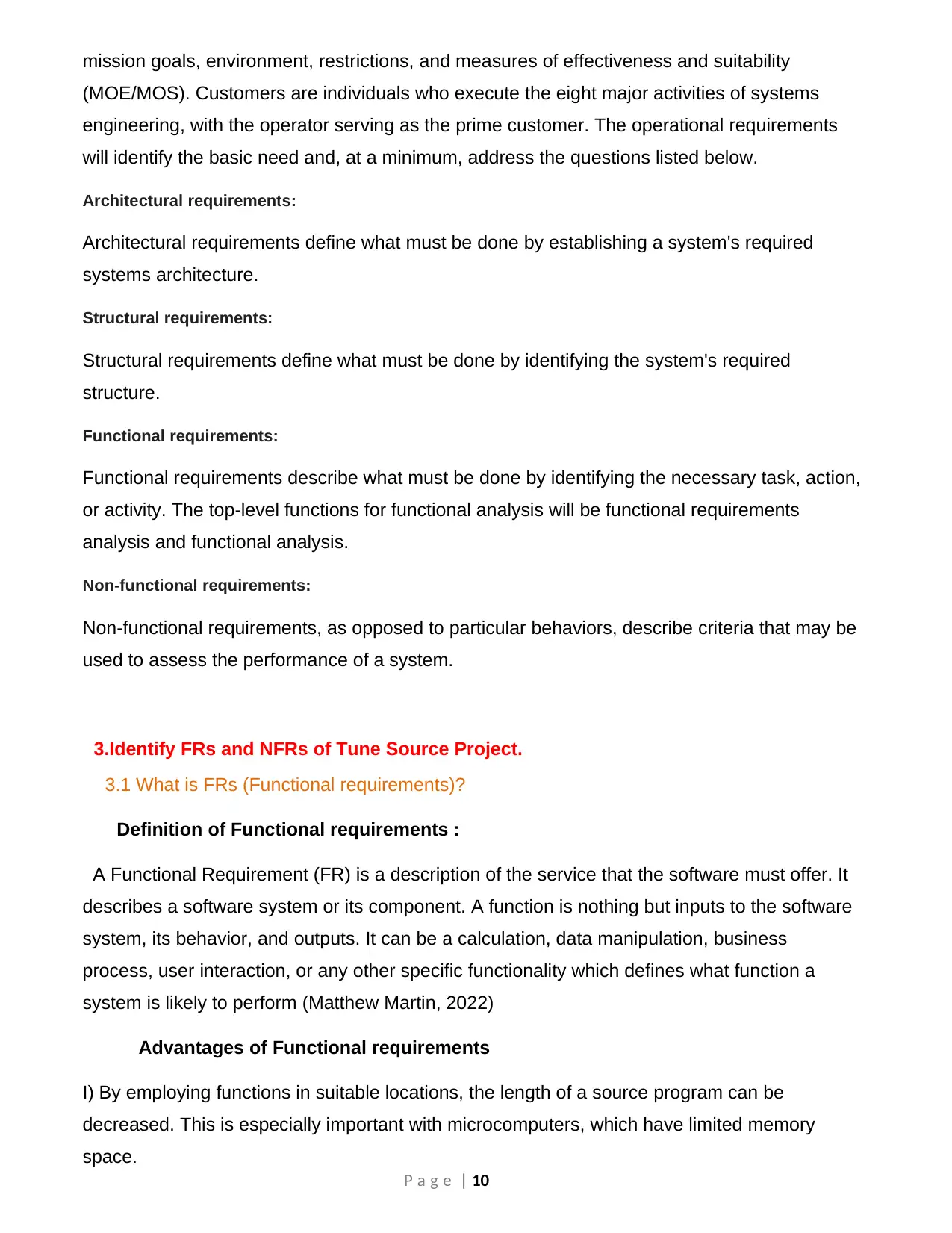
mission goals, environment, restrictions, and measures of effectiveness and suitability
(MOE/MOS). Customers are individuals who execute the eight major activities of systems
engineering, with the operator serving as the prime customer. The operational requirements
will identify the basic need and, at a minimum, address the questions listed below.
Architectural requirements:
Architectural requirements define what must be done by establishing a system's required
systems architecture.
Structural requirements:
Structural requirements define what must be done by identifying the system's required
structure.
Functional requirements:
Functional requirements describe what must be done by identifying the necessary task, action,
or activity. The top-level functions for functional analysis will be functional requirements
analysis and functional analysis.
Non-functional requirements:
Non-functional requirements, as opposed to particular behaviors, describe criteria that may be
used to assess the performance of a system.
3.Identify FRs and NFRs of Tune Source Project.
3.1 What is FRs (Functional requirements)?
Definition of Functional requirements :
A Functional Requirement (FR) is a description of the service that the software must offer. It
describes a software system or its component. A function is nothing but inputs to the software
system, its behavior, and outputs. It can be a calculation, data manipulation, business
process, user interaction, or any other specific functionality which defines what function a
system is likely to perform (Matthew Martin, 2022)
Advantages of Functional requirements
I) By employing functions in suitable locations, the length of a source program can be
decreased. This is especially important with microcomputers, which have limited memory
space.
P a g e | 10
(MOE/MOS). Customers are individuals who execute the eight major activities of systems
engineering, with the operator serving as the prime customer. The operational requirements
will identify the basic need and, at a minimum, address the questions listed below.
Architectural requirements:
Architectural requirements define what must be done by establishing a system's required
systems architecture.
Structural requirements:
Structural requirements define what must be done by identifying the system's required
structure.
Functional requirements:
Functional requirements describe what must be done by identifying the necessary task, action,
or activity. The top-level functions for functional analysis will be functional requirements
analysis and functional analysis.
Non-functional requirements:
Non-functional requirements, as opposed to particular behaviors, describe criteria that may be
used to assess the performance of a system.
3.Identify FRs and NFRs of Tune Source Project.
3.1 What is FRs (Functional requirements)?
Definition of Functional requirements :
A Functional Requirement (FR) is a description of the service that the software must offer. It
describes a software system or its component. A function is nothing but inputs to the software
system, its behavior, and outputs. It can be a calculation, data manipulation, business
process, user interaction, or any other specific functionality which defines what function a
system is likely to perform (Matthew Martin, 2022)
Advantages of Functional requirements
I) By employing functions in suitable locations, the length of a source program can be
decreased. This is especially important with microcomputers, which have limited memory
space.
P a g e | 10
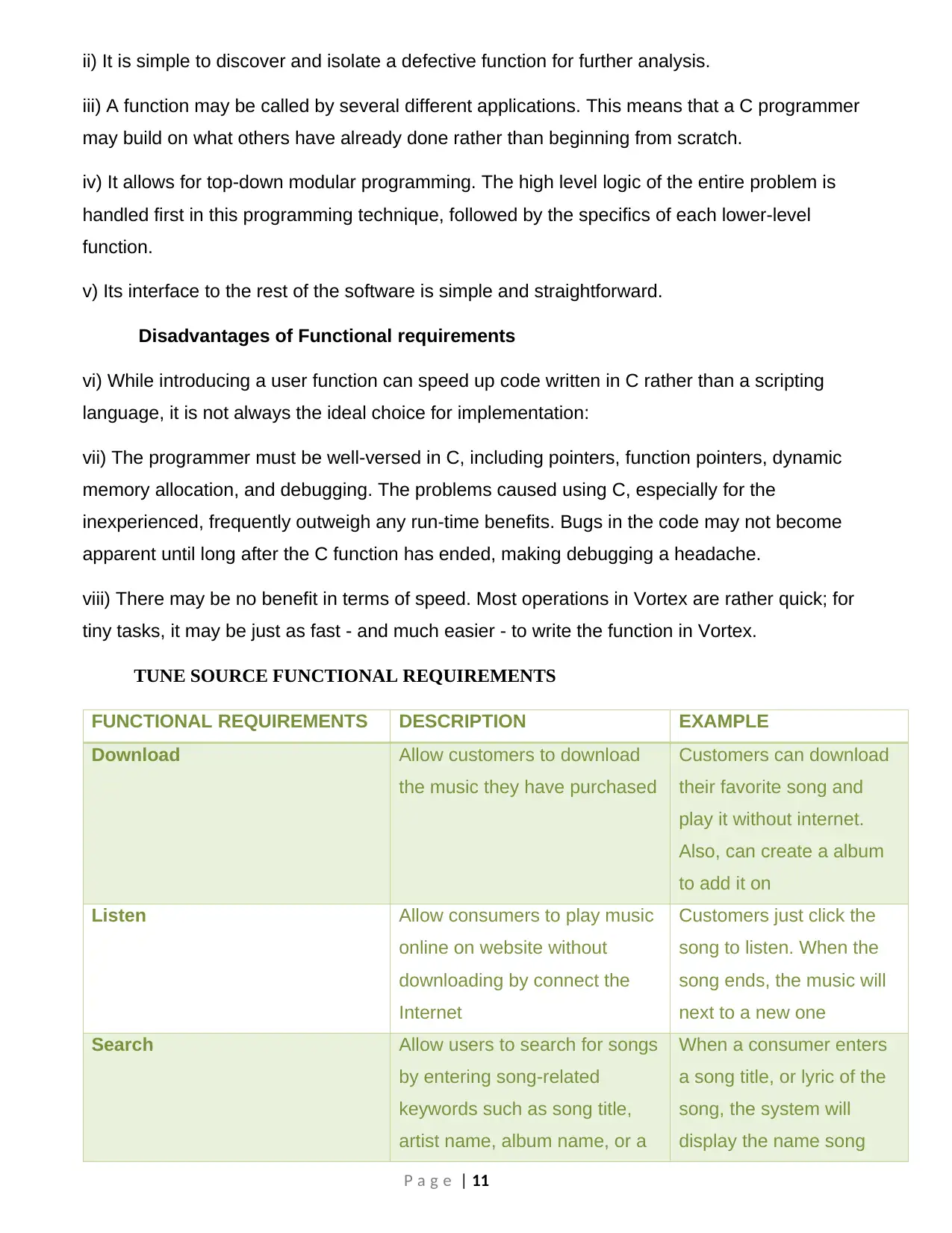
ii) It is simple to discover and isolate a defective function for further analysis.
iii) A function may be called by several different applications. This means that a C programmer
may build on what others have already done rather than beginning from scratch.
iv) It allows for top-down modular programming. The high level logic of the entire problem is
handled first in this programming technique, followed by the specifics of each lower-level
function.
v) Its interface to the rest of the software is simple and straightforward.
Disadvantages of Functional requirements
vi) While introducing a user function can speed up code written in C rather than a scripting
language, it is not always the ideal choice for implementation:
vii) The programmer must be well-versed in C, including pointers, function pointers, dynamic
memory allocation, and debugging. The problems caused using C, especially for the
inexperienced, frequently outweigh any run-time benefits. Bugs in the code may not become
apparent until long after the C function has ended, making debugging a headache.
viii) There may be no benefit in terms of speed. Most operations in Vortex are rather quick; for
tiny tasks, it may be just as fast - and much easier - to write the function in Vortex.
TUNE SOURCE FUNCTIONAL REQUIREMENTS
FUNCTIONAL REQUIREMENTS DESCRIPTION EXAMPLE
Download Allow customers to download
the music they have purchased
Customers can download
their favorite song and
play it without internet.
Also, can create a album
to add it on
Listen Allow consumers to play music
online on website without
downloading by connect the
Internet
Customers just click the
song to listen. When the
song ends, the music will
next to a new one
Search Allow users to search for songs
by entering song-related
keywords such as song title,
artist name, album name, or a
When a consumer enters
a song title, or lyric of the
song, the system will
display the name song
P a g e | 11
iii) A function may be called by several different applications. This means that a C programmer
may build on what others have already done rather than beginning from scratch.
iv) It allows for top-down modular programming. The high level logic of the entire problem is
handled first in this programming technique, followed by the specifics of each lower-level
function.
v) Its interface to the rest of the software is simple and straightforward.
Disadvantages of Functional requirements
vi) While introducing a user function can speed up code written in C rather than a scripting
language, it is not always the ideal choice for implementation:
vii) The programmer must be well-versed in C, including pointers, function pointers, dynamic
memory allocation, and debugging. The problems caused using C, especially for the
inexperienced, frequently outweigh any run-time benefits. Bugs in the code may not become
apparent until long after the C function has ended, making debugging a headache.
viii) There may be no benefit in terms of speed. Most operations in Vortex are rather quick; for
tiny tasks, it may be just as fast - and much easier - to write the function in Vortex.
TUNE SOURCE FUNCTIONAL REQUIREMENTS
FUNCTIONAL REQUIREMENTS DESCRIPTION EXAMPLE
Download Allow customers to download
the music they have purchased
Customers can download
their favorite song and
play it without internet.
Also, can create a album
to add it on
Listen Allow consumers to play music
online on website without
downloading by connect the
Internet
Customers just click the
song to listen. When the
song ends, the music will
next to a new one
Search Allow users to search for songs
by entering song-related
keywords such as song title,
artist name, album name, or a
When a consumer enters
a song title, or lyric of the
song, the system will
display the name song
P a g e | 11
Paraphrase This Document
Need a fresh take? Get an instant paraphrase of this document with our AI Paraphraser
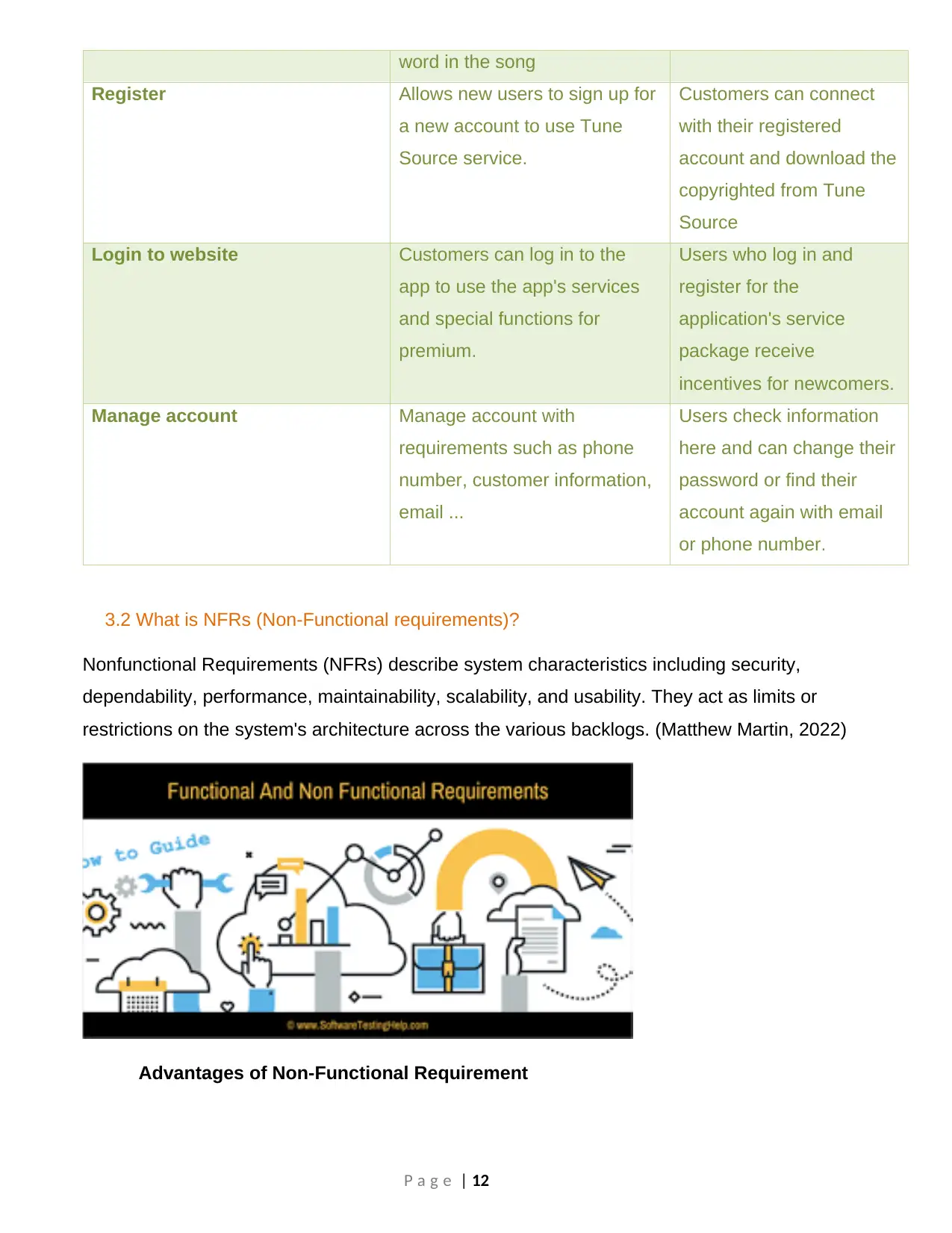
word in the song
Register Allows new users to sign up for
a new account to use Tune
Source service.
Customers can connect
with their registered
account and download the
copyrighted from Tune
Source
Login to website Customers can log in to the
app to use the app's services
and special functions for
premium.
Users who log in and
register for the
application's service
package receive
incentives for newcomers.
Manage account Manage account with
requirements such as phone
number, customer information,
email ...
Users check information
here and can change their
password or find their
account again with email
or phone number.
3.2 What is NFRs (Non-Functional requirements)?
Nonfunctional Requirements (NFRs) describe system characteristics including security,
dependability, performance, maintainability, scalability, and usability. They act as limits or
restrictions on the system's architecture across the various backlogs. (Matthew Martin, 2022)
Advantages of Non-Functional Requirement
P a g e | 12
Register Allows new users to sign up for
a new account to use Tune
Source service.
Customers can connect
with their registered
account and download the
copyrighted from Tune
Source
Login to website Customers can log in to the
app to use the app's services
and special functions for
premium.
Users who log in and
register for the
application's service
package receive
incentives for newcomers.
Manage account Manage account with
requirements such as phone
number, customer information,
email ...
Users check information
here and can change their
password or find their
account again with email
or phone number.
3.2 What is NFRs (Non-Functional requirements)?
Nonfunctional Requirements (NFRs) describe system characteristics including security,
dependability, performance, maintainability, scalability, and usability. They act as limits or
restrictions on the system's architecture across the various backlogs. (Matthew Martin, 2022)
Advantages of Non-Functional Requirement
P a g e | 12
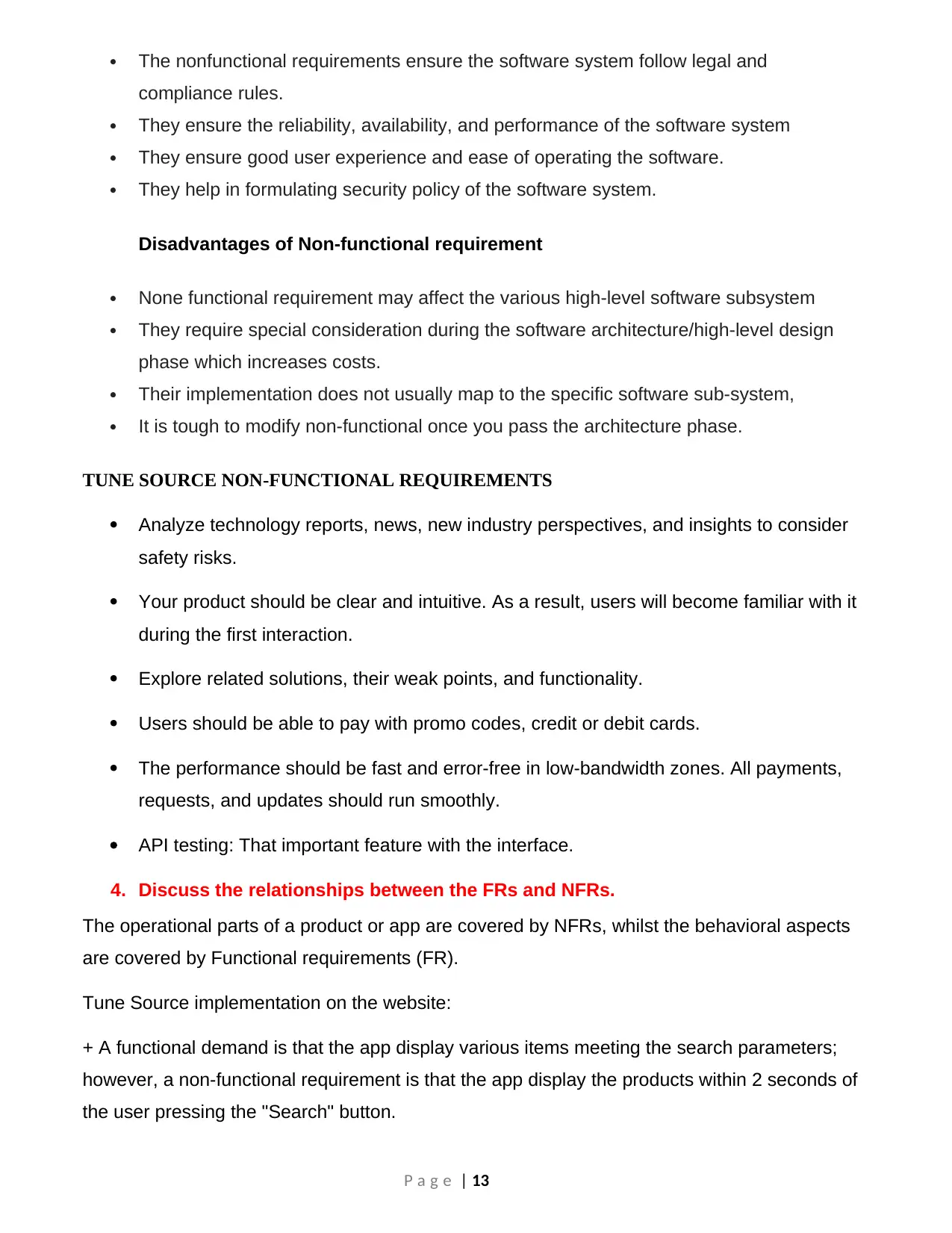
The nonfunctional requirements ensure the software system follow legal and
compliance rules.
They ensure the reliability, availability, and performance of the software system
They ensure good user experience and ease of operating the software.
They help in formulating security policy of the software system.
Disadvantages of Non-functional requirement
None functional requirement may affect the various high-level software subsystem
They require special consideration during the software architecture/high-level design
phase which increases costs.
Their implementation does not usually map to the specific software sub-system,
It is tough to modify non-functional once you pass the architecture phase.
TUNE SOURCE NON-FUNCTIONAL REQUIREMENTS
Analyze technology reports, news, new industry perspectives, and insights to consider
safety risks.
Your product should be clear and intuitive. As a result, users will become familiar with it
during the first interaction.
Explore related solutions, their weak points, and functionality.
Users should be able to pay with promo codes, credit or debit cards.
The performance should be fast and error-free in low-bandwidth zones. All payments,
requests, and updates should run smoothly.
API testing: That important feature with the interface.
4. Discuss the relationships between the FRs and NFRs.
The operational parts of a product or app are covered by NFRs, whilst the behavioral aspects
are covered by Functional requirements (FR).
Tune Source implementation on the website:
+ A functional demand is that the app display various items meeting the search parameters;
however, a non-functional requirement is that the app display the products within 2 seconds of
the user pressing the "Search" button.
P a g e | 13
compliance rules.
They ensure the reliability, availability, and performance of the software system
They ensure good user experience and ease of operating the software.
They help in formulating security policy of the software system.
Disadvantages of Non-functional requirement
None functional requirement may affect the various high-level software subsystem
They require special consideration during the software architecture/high-level design
phase which increases costs.
Their implementation does not usually map to the specific software sub-system,
It is tough to modify non-functional once you pass the architecture phase.
TUNE SOURCE NON-FUNCTIONAL REQUIREMENTS
Analyze technology reports, news, new industry perspectives, and insights to consider
safety risks.
Your product should be clear and intuitive. As a result, users will become familiar with it
during the first interaction.
Explore related solutions, their weak points, and functionality.
Users should be able to pay with promo codes, credit or debit cards.
The performance should be fast and error-free in low-bandwidth zones. All payments,
requests, and updates should run smoothly.
API testing: That important feature with the interface.
4. Discuss the relationships between the FRs and NFRs.
The operational parts of a product or app are covered by NFRs, whilst the behavioral aspects
are covered by Functional requirements (FR).
Tune Source implementation on the website:
+ A functional demand is that the app display various items meeting the search parameters;
however, a non-functional requirement is that the app display the products within 2 seconds of
the user pressing the "Search" button.
P a g e | 13
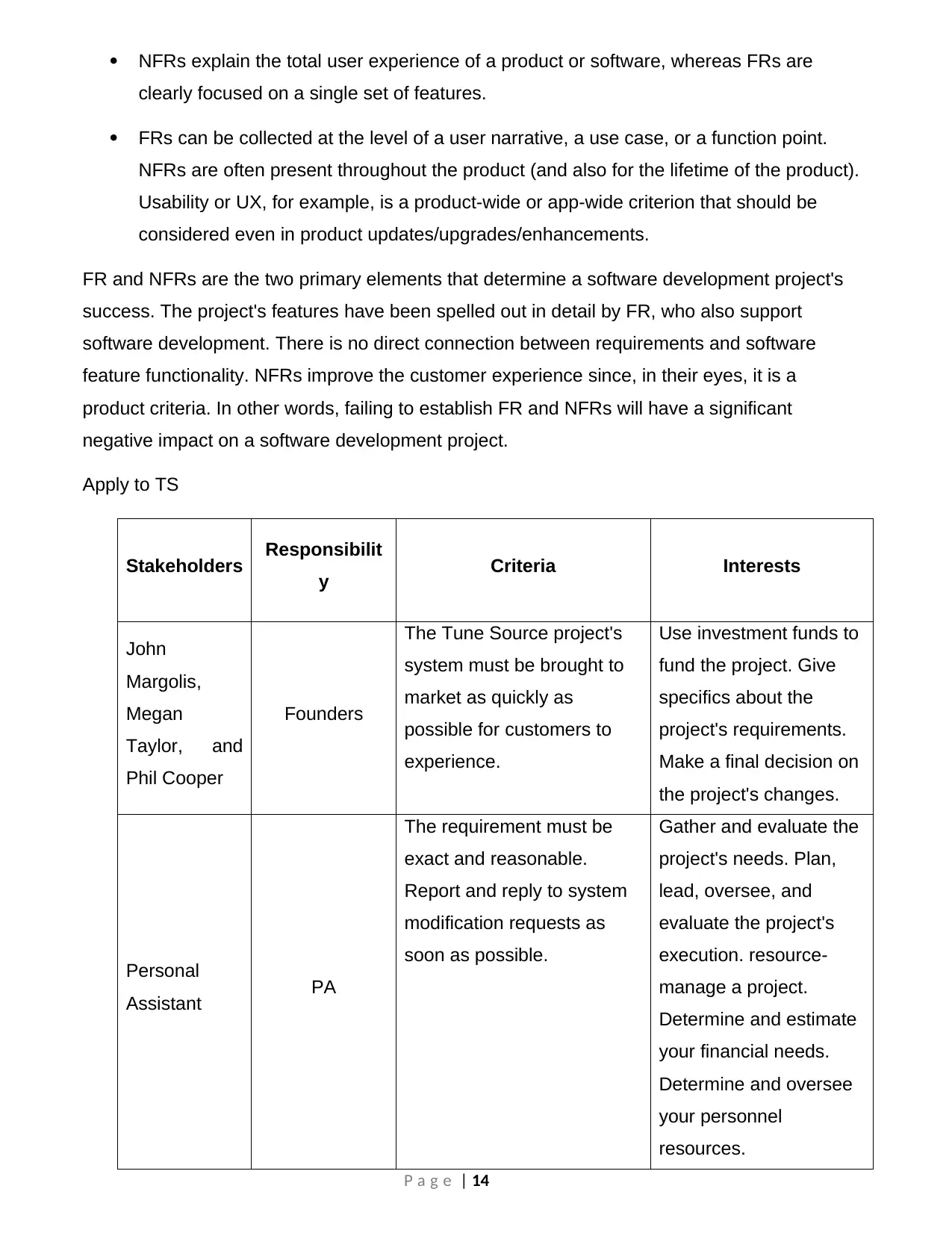
NFRs explain the total user experience of a product or software, whereas FRs are
clearly focused on a single set of features.
FRs can be collected at the level of a user narrative, a use case, or a function point.
NFRs are often present throughout the product (and also for the lifetime of the product).
Usability or UX, for example, is a product-wide or app-wide criterion that should be
considered even in product updates/upgrades/enhancements.
FR and NFRs are the two primary elements that determine a software development project's
success. The project's features have been spelled out in detail by FR, who also support
software development. There is no direct connection between requirements and software
feature functionality. NFRs improve the customer experience since, in their eyes, it is a
product criteria. In other words, failing to establish FR and NFRs will have a significant
negative impact on a software development project.
Apply to TS
Stakeholders Responsibilit
y Criteria Interests
John
Margolis,
Megan
Taylor, and
Phil Cooper
Founders
The Tune Source project's
system must be brought to
market as quickly as
possible for customers to
experience.
Use investment funds to
fund the project. Give
specifics about the
project's requirements.
Make a final decision on
the project's changes.
Personal
Assistant PA
The requirement must be
exact and reasonable.
Report and reply to system
modification requests as
soon as possible.
Gather and evaluate the
project's needs. Plan,
lead, oversee, and
evaluate the project's
execution. resource-
manage a project.
Determine and estimate
your financial needs.
Determine and oversee
your personnel
resources.
P a g e | 14
clearly focused on a single set of features.
FRs can be collected at the level of a user narrative, a use case, or a function point.
NFRs are often present throughout the product (and also for the lifetime of the product).
Usability or UX, for example, is a product-wide or app-wide criterion that should be
considered even in product updates/upgrades/enhancements.
FR and NFRs are the two primary elements that determine a software development project's
success. The project's features have been spelled out in detail by FR, who also support
software development. There is no direct connection between requirements and software
feature functionality. NFRs improve the customer experience since, in their eyes, it is a
product criteria. In other words, failing to establish FR and NFRs will have a significant
negative impact on a software development project.
Apply to TS
Stakeholders Responsibilit
y Criteria Interests
John
Margolis,
Megan
Taylor, and
Phil Cooper
Founders
The Tune Source project's
system must be brought to
market as quickly as
possible for customers to
experience.
Use investment funds to
fund the project. Give
specifics about the
project's requirements.
Make a final decision on
the project's changes.
Personal
Assistant PA
The requirement must be
exact and reasonable.
Report and reply to system
modification requests as
soon as possible.
Gather and evaluate the
project's needs. Plan,
lead, oversee, and
evaluate the project's
execution. resource-
manage a project.
Determine and estimate
your financial needs.
Determine and oversee
your personnel
resources.
P a g e | 14
Secure Best Marks with AI Grader
Need help grading? Try our AI Grader for instant feedback on your assignments.

Carly
Edwards,
Assistant Vice
President,
Marketing
Sponsor
Obtain a fresh source of
income from consumer
download service
subscriptions. Expect some
cross-selling to increase if
consumers who have
downloaded a track or two
from a CD decide to buy the
complete CD in a store or
via our website. The selling
of music download gift cards
is expected to generate new
revenue.
Prepare project
proposals and contract
agreements in
coordination with
management. Keep
track of and report on
project productivity and
quality. Identify, assess,
and manage risks that
have an impact on
product quality.
Implementation of
product promotion
strategies for the Tune
Source project
Developer
department
Developer
&
Maintainer
Providing cutting-edge
technology and equipment
Gives thorough explanations
of the functionalities that will
be developed.
Performs project design
and development tasks
in accordance with the
required specifications.
Coordination with
management in the
preparation of
technology and
equipment
recommendations for
project implementation.
To carry out project
development duties,
conduct research and
suggest new
technologies.
Performing upgrades
and website
maintenance of Tune
P a g e | 15
Edwards,
Assistant Vice
President,
Marketing
Sponsor
Obtain a fresh source of
income from consumer
download service
subscriptions. Expect some
cross-selling to increase if
consumers who have
downloaded a track or two
from a CD decide to buy the
complete CD in a store or
via our website. The selling
of music download gift cards
is expected to generate new
revenue.
Prepare project
proposals and contract
agreements in
coordination with
management. Keep
track of and report on
project productivity and
quality. Identify, assess,
and manage risks that
have an impact on
product quality.
Implementation of
product promotion
strategies for the Tune
Source project
Developer
department
Developer
&
Maintainer
Providing cutting-edge
technology and equipment
Gives thorough explanations
of the functionalities that will
be developed.
Performs project design
and development tasks
in accordance with the
required specifications.
Coordination with
management in the
preparation of
technology and
equipment
recommendations for
project implementation.
To carry out project
development duties,
conduct research and
suggest new
technologies.
Performing upgrades
and website
maintenance of Tune
P a g e | 15
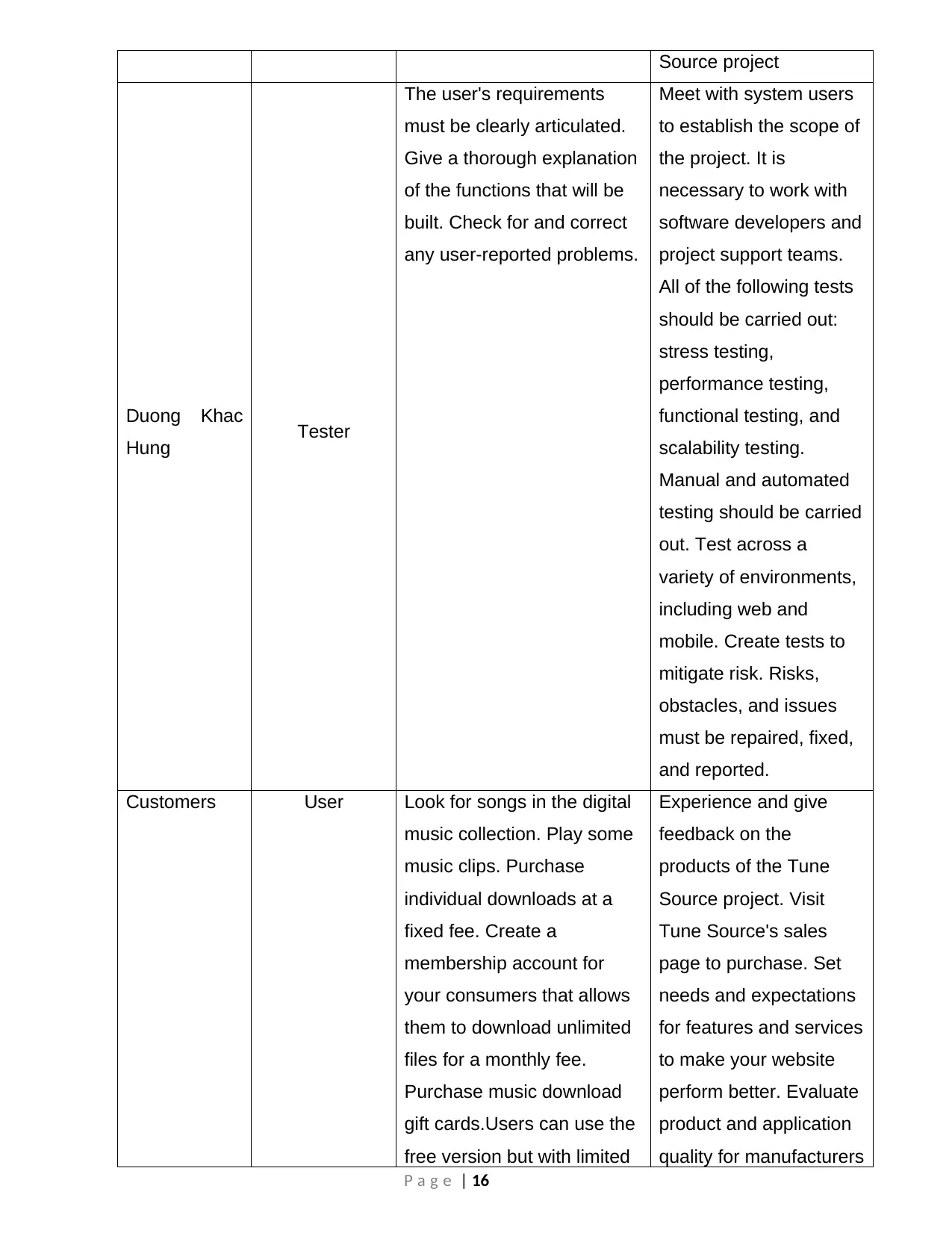
Source project
Duong Khac
Hung Tester
The user's requirements
must be clearly articulated.
Give a thorough explanation
of the functions that will be
built. Check for and correct
any user-reported problems.
Meet with system users
to establish the scope of
the project. It is
necessary to work with
software developers and
project support teams.
All of the following tests
should be carried out:
stress testing,
performance testing,
functional testing, and
scalability testing.
Manual and automated
testing should be carried
out. Test across a
variety of environments,
including web and
mobile. Create tests to
mitigate risk. Risks,
obstacles, and issues
must be repaired, fixed,
and reported.
Customers User Look for songs in the digital
music collection. Play some
music clips. Purchase
individual downloads at a
fixed fee. Create a
membership account for
your consumers that allows
them to download unlimited
files for a monthly fee.
Purchase music download
gift cards.Users can use the
free version but with limited
Experience and give
feedback on the
products of the Tune
Source project. Visit
Tune Source's sales
page to purchase. Set
needs and expectations
for features and services
to make your website
perform better. Evaluate
product and application
quality for manufacturers
P a g e | 16
Duong Khac
Hung Tester
The user's requirements
must be clearly articulated.
Give a thorough explanation
of the functions that will be
built. Check for and correct
any user-reported problems.
Meet with system users
to establish the scope of
the project. It is
necessary to work with
software developers and
project support teams.
All of the following tests
should be carried out:
stress testing,
performance testing,
functional testing, and
scalability testing.
Manual and automated
testing should be carried
out. Test across a
variety of environments,
including web and
mobile. Create tests to
mitigate risk. Risks,
obstacles, and issues
must be repaired, fixed,
and reported.
Customers User Look for songs in the digital
music collection. Play some
music clips. Purchase
individual downloads at a
fixed fee. Create a
membership account for
your consumers that allows
them to download unlimited
files for a monthly fee.
Purchase music download
gift cards.Users can use the
free version but with limited
Experience and give
feedback on the
products of the Tune
Source project. Visit
Tune Source's sales
page to purchase. Set
needs and expectations
for features and services
to make your website
perform better. Evaluate
product and application
quality for manufacturers
P a g e | 16
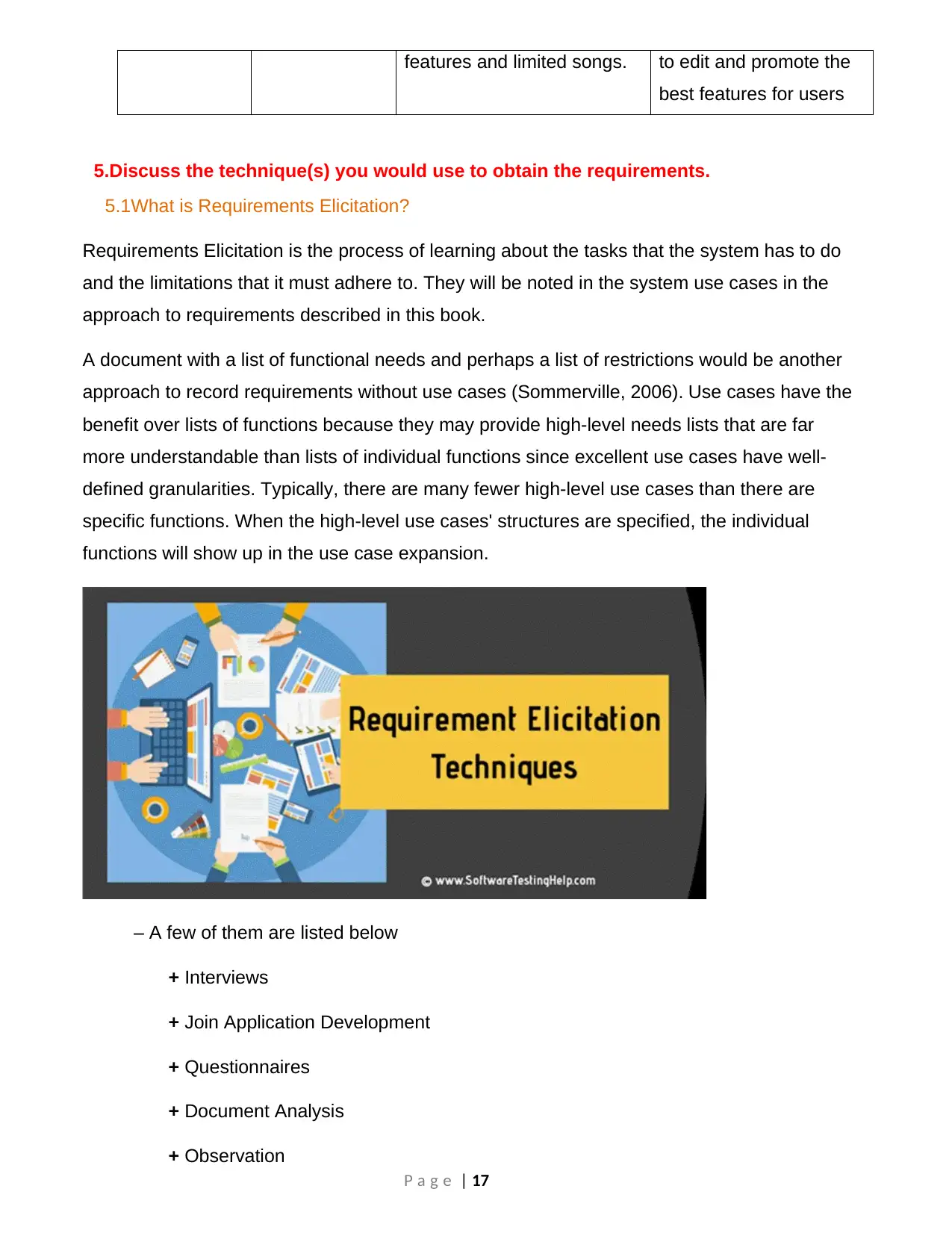
features and limited songs. to edit and promote the
best features for users
5.Discuss the technique(s) you would use to obtain the requirements.
5.1What is Requirements Elicitation?
Requirements Elicitation is the process of learning about the tasks that the system has to do
and the limitations that it must adhere to. They will be noted in the system use cases in the
approach to requirements described in this book.
A document with a list of functional needs and perhaps a list of restrictions would be another
approach to record requirements without use cases (Sommerville, 2006). Use cases have the
benefit over lists of functions because they may provide high-level needs lists that are far
more understandable than lists of individual functions since excellent use cases have well-
defined granularities. Typically, there are many fewer high-level use cases than there are
specific functions. When the high-level use cases' structures are specified, the individual
functions will show up in the use case expansion.
– A few of them are listed below
+ Interviews
+ Join Application Development
+ Questionnaires
+ Document Analysis
+ Observation
P a g e | 17
best features for users
5.Discuss the technique(s) you would use to obtain the requirements.
5.1What is Requirements Elicitation?
Requirements Elicitation is the process of learning about the tasks that the system has to do
and the limitations that it must adhere to. They will be noted in the system use cases in the
approach to requirements described in this book.
A document with a list of functional needs and perhaps a list of restrictions would be another
approach to record requirements without use cases (Sommerville, 2006). Use cases have the
benefit over lists of functions because they may provide high-level needs lists that are far
more understandable than lists of individual functions since excellent use cases have well-
defined granularities. Typically, there are many fewer high-level use cases than there are
specific functions. When the high-level use cases' structures are specified, the individual
functions will show up in the use case expansion.
– A few of them are listed below
+ Interviews
+ Join Application Development
+ Questionnaires
+ Document Analysis
+ Observation
P a g e | 17
Paraphrase This Document
Need a fresh take? Get an instant paraphrase of this document with our AI Paraphraser
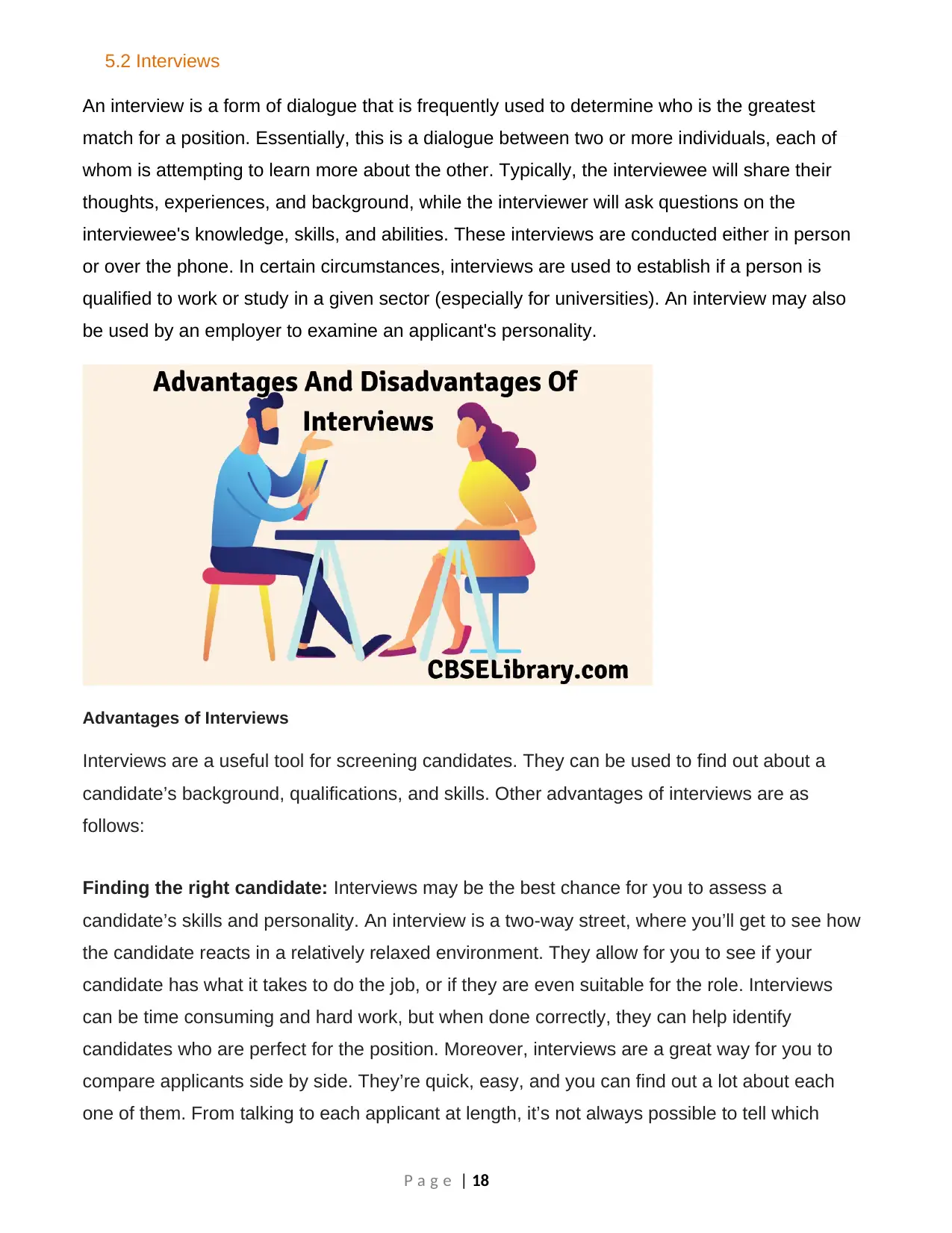
5.2 Interviews
An interview is a form of dialogue that is frequently used to determine who is the greatest
match for a position. Essentially, this is a dialogue between two or more individuals, each of
whom is attempting to learn more about the other. Typically, the interviewee will share their
thoughts, experiences, and background, while the interviewer will ask questions on the
interviewee's knowledge, skills, and abilities. These interviews are conducted either in person
or over the phone. In certain circumstances, interviews are used to establish if a person is
qualified to work or study in a given sector (especially for universities). An interview may also
be used by an employer to examine an applicant's personality.
Advantages of Interviews
Interviews are a useful tool for screening candidates. They can be used to find out about a
candidate’s background, qualifications, and skills. Other advantages of interviews are as
follows:
Finding the right candidate: Interviews may be the best chance for you to assess a
candidate’s skills and personality. An interview is a two-way street, where you’ll get to see how
the candidate reacts in a relatively relaxed environment. They allow for you to see if your
candidate has what it takes to do the job, or if they are even suitable for the role. Interviews
can be time consuming and hard work, but when done correctly, they can help identify
candidates who are perfect for the position. Moreover, interviews are a great way for you to
compare applicants side by side. They’re quick, easy, and you can find out a lot about each
one of them. From talking to each applicant at length, it’s not always possible to tell which
P a g e | 18
An interview is a form of dialogue that is frequently used to determine who is the greatest
match for a position. Essentially, this is a dialogue between two or more individuals, each of
whom is attempting to learn more about the other. Typically, the interviewee will share their
thoughts, experiences, and background, while the interviewer will ask questions on the
interviewee's knowledge, skills, and abilities. These interviews are conducted either in person
or over the phone. In certain circumstances, interviews are used to establish if a person is
qualified to work or study in a given sector (especially for universities). An interview may also
be used by an employer to examine an applicant's personality.
Advantages of Interviews
Interviews are a useful tool for screening candidates. They can be used to find out about a
candidate’s background, qualifications, and skills. Other advantages of interviews are as
follows:
Finding the right candidate: Interviews may be the best chance for you to assess a
candidate’s skills and personality. An interview is a two-way street, where you’ll get to see how
the candidate reacts in a relatively relaxed environment. They allow for you to see if your
candidate has what it takes to do the job, or if they are even suitable for the role. Interviews
can be time consuming and hard work, but when done correctly, they can help identify
candidates who are perfect for the position. Moreover, interviews are a great way for you to
compare applicants side by side. They’re quick, easy, and you can find out a lot about each
one of them. From talking to each applicant at length, it’s not always possible to tell which
P a g e | 18
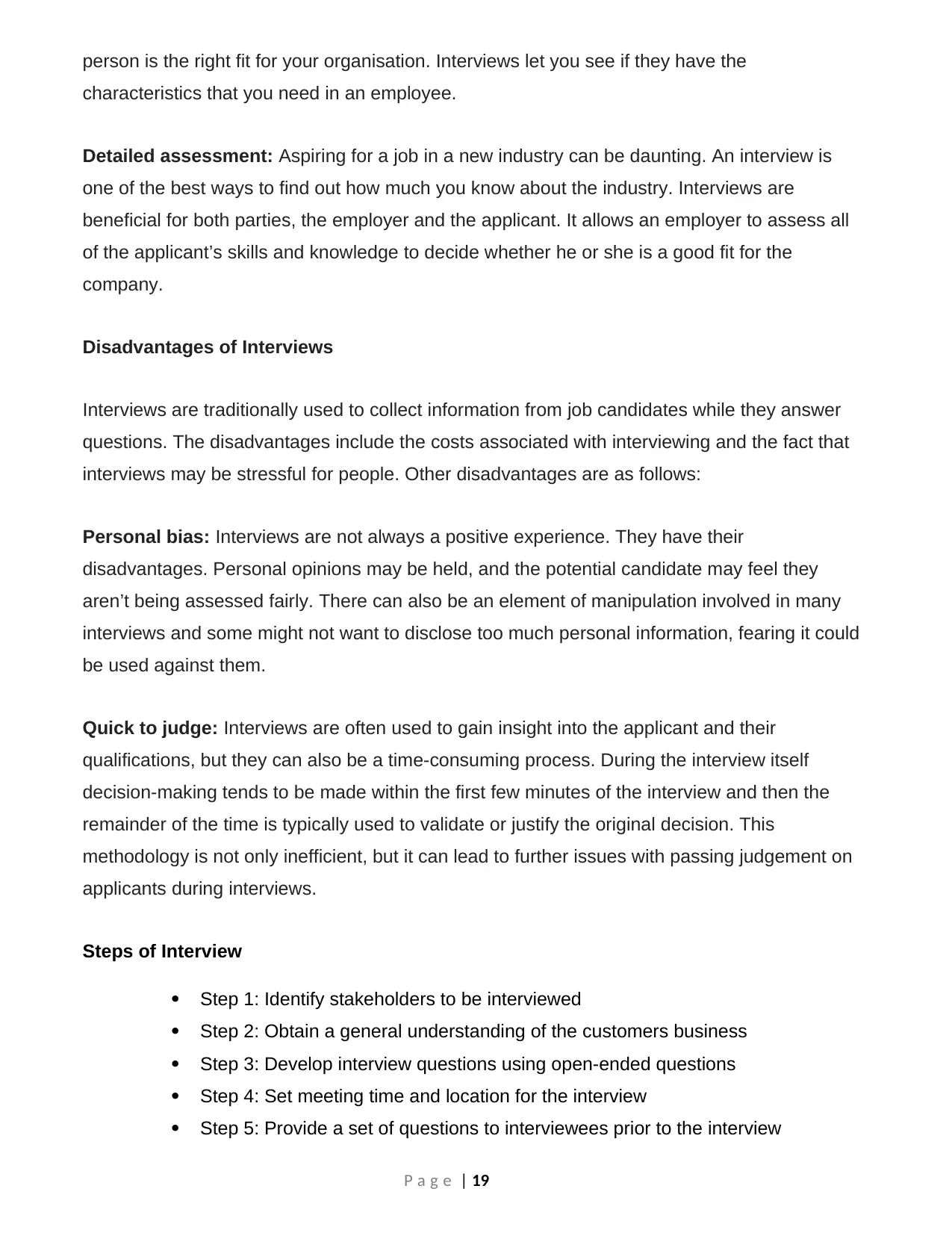
person is the right fit for your organisation. Interviews let you see if they have the
characteristics that you need in an employee.
Detailed assessment: Aspiring for a job in a new industry can be daunting. An interview is
one of the best ways to find out how much you know about the industry. Interviews are
beneficial for both parties, the employer and the applicant. It allows an employer to assess all
of the applicant’s skills and knowledge to decide whether he or she is a good fit for the
company.
Disadvantages of Interviews
Interviews are traditionally used to collect information from job candidates while they answer
questions. The disadvantages include the costs associated with interviewing and the fact that
interviews may be stressful for people. Other disadvantages are as follows:
Personal bias: Interviews are not always a positive experience. They have their
disadvantages. Personal opinions may be held, and the potential candidate may feel they
aren’t being assessed fairly. There can also be an element of manipulation involved in many
interviews and some might not want to disclose too much personal information, fearing it could
be used against them.
Quick to judge: Interviews are often used to gain insight into the applicant and their
qualifications, but they can also be a time-consuming process. During the interview itself
decision-making tends to be made within the first few minutes of the interview and then the
remainder of the time is typically used to validate or justify the original decision. This
methodology is not only inefficient, but it can lead to further issues with passing judgement on
applicants during interviews.
Steps of Interview
Step 1: Identify stakeholders to be interviewed
Step 2: Obtain a general understanding of the customers business
Step 3: Develop interview questions using open-ended questions
Step 4: Set meeting time and location for the interview
Step 5: Provide a set of questions to interviewees prior to the interview
P a g e | 19
characteristics that you need in an employee.
Detailed assessment: Aspiring for a job in a new industry can be daunting. An interview is
one of the best ways to find out how much you know about the industry. Interviews are
beneficial for both parties, the employer and the applicant. It allows an employer to assess all
of the applicant’s skills and knowledge to decide whether he or she is a good fit for the
company.
Disadvantages of Interviews
Interviews are traditionally used to collect information from job candidates while they answer
questions. The disadvantages include the costs associated with interviewing and the fact that
interviews may be stressful for people. Other disadvantages are as follows:
Personal bias: Interviews are not always a positive experience. They have their
disadvantages. Personal opinions may be held, and the potential candidate may feel they
aren’t being assessed fairly. There can also be an element of manipulation involved in many
interviews and some might not want to disclose too much personal information, fearing it could
be used against them.
Quick to judge: Interviews are often used to gain insight into the applicant and their
qualifications, but they can also be a time-consuming process. During the interview itself
decision-making tends to be made within the first few minutes of the interview and then the
remainder of the time is typically used to validate or justify the original decision. This
methodology is not only inefficient, but it can lead to further issues with passing judgement on
applicants during interviews.
Steps of Interview
Step 1: Identify stakeholders to be interviewed
Step 2: Obtain a general understanding of the customers business
Step 3: Develop interview questions using open-ended questions
Step 4: Set meeting time and location for the interview
Step 5: Provide a set of questions to interviewees prior to the interview
P a g e | 19
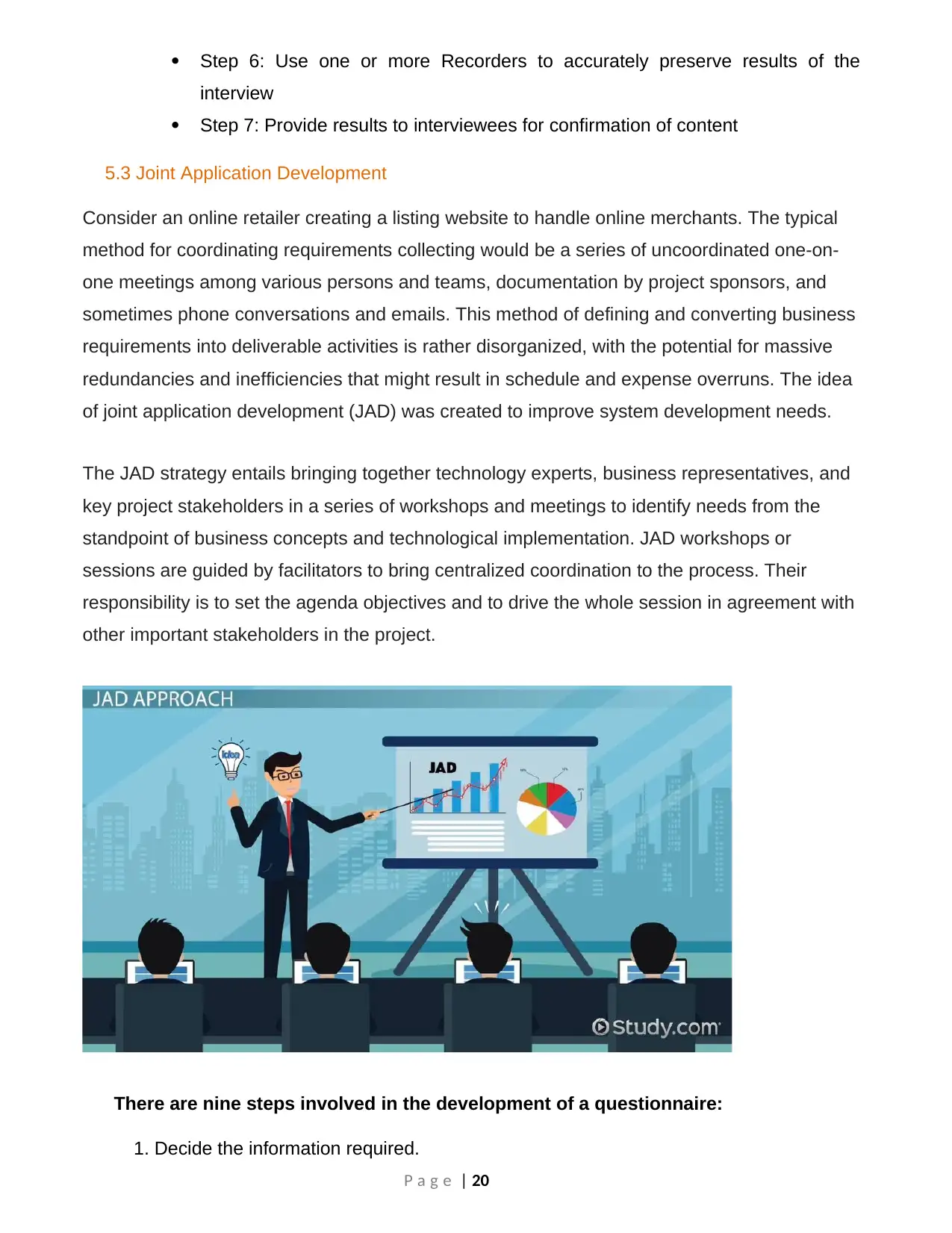
Step 6: Use one or more Recorders to accurately preserve results of the
interview
Step 7: Provide results to interviewees for confirmation of content
5.3 Joint Application Development
Consider an online retailer creating a listing website to handle online merchants. The typical
method for coordinating requirements collecting would be a series of uncoordinated one-on-
one meetings among various persons and teams, documentation by project sponsors, and
sometimes phone conversations and emails. This method of defining and converting business
requirements into deliverable activities is rather disorganized, with the potential for massive
redundancies and inefficiencies that might result in schedule and expense overruns. The idea
of joint application development (JAD) was created to improve system development needs.
The JAD strategy entails bringing together technology experts, business representatives, and
key project stakeholders in a series of workshops and meetings to identify needs from the
standpoint of business concepts and technological implementation. JAD workshops or
sessions are guided by facilitators to bring centralized coordination to the process. Their
responsibility is to set the agenda objectives and to drive the whole session in agreement with
other important stakeholders in the project.
There are nine steps involved in the development of a questionnaire:
1. Decide the information required.
P a g e | 20
interview
Step 7: Provide results to interviewees for confirmation of content
5.3 Joint Application Development
Consider an online retailer creating a listing website to handle online merchants. The typical
method for coordinating requirements collecting would be a series of uncoordinated one-on-
one meetings among various persons and teams, documentation by project sponsors, and
sometimes phone conversations and emails. This method of defining and converting business
requirements into deliverable activities is rather disorganized, with the potential for massive
redundancies and inefficiencies that might result in schedule and expense overruns. The idea
of joint application development (JAD) was created to improve system development needs.
The JAD strategy entails bringing together technology experts, business representatives, and
key project stakeholders in a series of workshops and meetings to identify needs from the
standpoint of business concepts and technological implementation. JAD workshops or
sessions are guided by facilitators to bring centralized coordination to the process. Their
responsibility is to set the agenda objectives and to drive the whole session in agreement with
other important stakeholders in the project.
There are nine steps involved in the development of a questionnaire:
1. Decide the information required.
P a g e | 20
Secure Best Marks with AI Grader
Need help grading? Try our AI Grader for instant feedback on your assignments.

2. Define the target respondents.
3. Choose the method(s) of reaching your target respondents.
4. Decide on question content.
5. Develop the question wording.
6. Put questions into a meaningful order and format.
7. Check the length of the questionnaire.
8. Pre-test the questionnaire.
9. Develop the final survey form.
Advantages
JAD allows you to resolve difficulties more simply and produce better, error-free software
The joint collaboration between the company and the clients lowers all risks
JAD reduces costs and time needed for project development
Well-defined requirements improve system quality
Due to the close communication, progress is faster
JAD encourages the team to push each other to work faster and deliver on time
Disadvantages
Different opinions within the team make it difficult to align goals and maintain focus.
Depending on the size of the project, JAD may require a significant time commitment.
5.4 Questionnaires
P a g e | 21
3. Choose the method(s) of reaching your target respondents.
4. Decide on question content.
5. Develop the question wording.
6. Put questions into a meaningful order and format.
7. Check the length of the questionnaire.
8. Pre-test the questionnaire.
9. Develop the final survey form.
Advantages
JAD allows you to resolve difficulties more simply and produce better, error-free software
The joint collaboration between the company and the clients lowers all risks
JAD reduces costs and time needed for project development
Well-defined requirements improve system quality
Due to the close communication, progress is faster
JAD encourages the team to push each other to work faster and deliver on time
Disadvantages
Different opinions within the team make it difficult to align goals and maintain focus.
Depending on the size of the project, JAD may require a significant time commitment.
5.4 Questionnaires
P a g e | 21
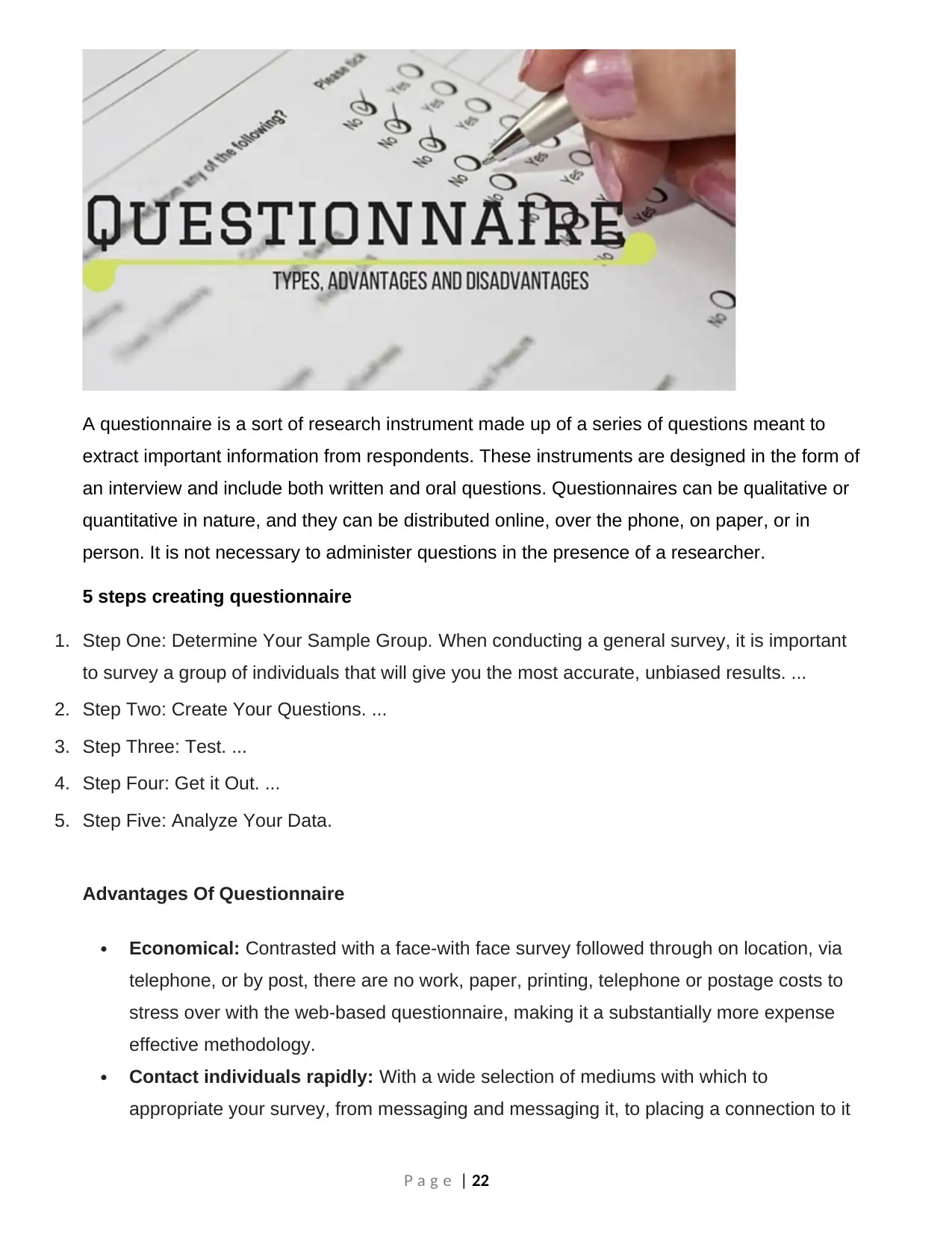
A questionnaire is a sort of research instrument made up of a series of questions meant to
extract important information from respondents. These instruments are designed in the form of
an interview and include both written and oral questions. Questionnaires can be qualitative or
quantitative in nature, and they can be distributed online, over the phone, on paper, or in
person. It is not necessary to administer questions in the presence of a researcher.
5 steps creating questionnaire
1. Step One: Determine Your Sample Group. When conducting a general survey, it is important
to survey a group of individuals that will give you the most accurate, unbiased results. ...
2. Step Two: Create Your Questions. ...
3. Step Three: Test. ...
4. Step Four: Get it Out. ...
5. Step Five: Analyze Your Data.
Advantages Of Questionnaire
Economical: Contrasted with a face-with face survey followed through on location, via
telephone, or by post, there are no work, paper, printing, telephone or postage costs to
stress over with the web-based questionnaire, making it a substantially more expense
effective methodology.
Contact individuals rapidly: With a wide selection of mediums with which to
appropriate your survey, from messaging and messaging it, to placing a connection to it
P a g e | 22
extract important information from respondents. These instruments are designed in the form of
an interview and include both written and oral questions. Questionnaires can be qualitative or
quantitative in nature, and they can be distributed online, over the phone, on paper, or in
person. It is not necessary to administer questions in the presence of a researcher.
5 steps creating questionnaire
1. Step One: Determine Your Sample Group. When conducting a general survey, it is important
to survey a group of individuals that will give you the most accurate, unbiased results. ...
2. Step Two: Create Your Questions. ...
3. Step Three: Test. ...
4. Step Four: Get it Out. ...
5. Step Five: Analyze Your Data.
Advantages Of Questionnaire
Economical: Contrasted with a face-with face survey followed through on location, via
telephone, or by post, there are no work, paper, printing, telephone or postage costs to
stress over with the web-based questionnaire, making it a substantially more expense
effective methodology.
Contact individuals rapidly: With a wide selection of mediums with which to
appropriate your survey, from messaging and messaging it, to placing a connection to it
P a g e | 22
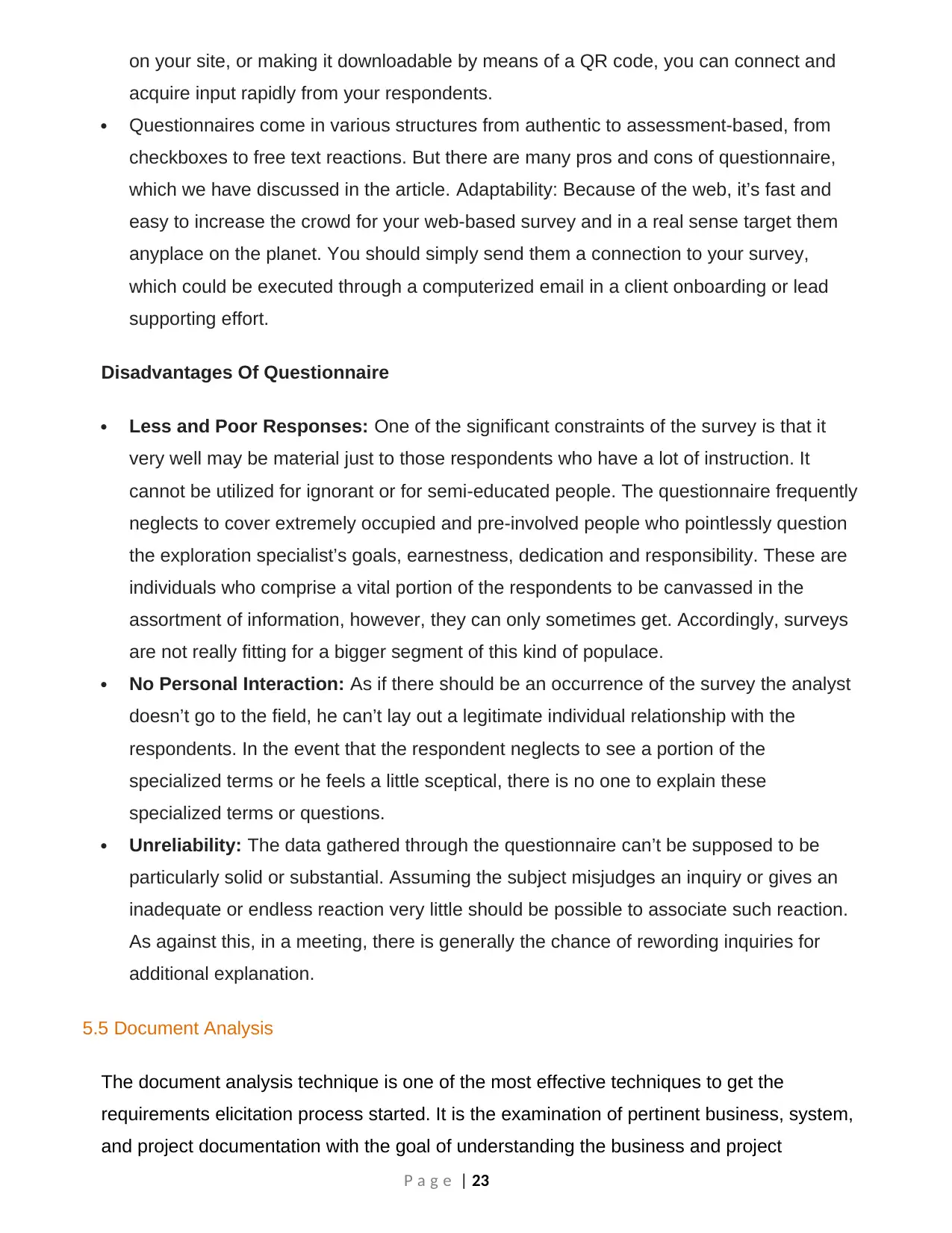
on your site, or making it downloadable by means of a QR code, you can connect and
acquire input rapidly from your respondents.
Questionnaires come in various structures from authentic to assessment-based, from
checkboxes to free text reactions. But there are many pros and cons of questionnaire,
which we have discussed in the article. Adaptability: Because of the web, it’s fast and
easy to increase the crowd for your web-based survey and in a real sense target them
anyplace on the planet. You should simply send them a connection to your survey,
which could be executed through a computerized email in a client onboarding or lead
supporting effort.
Disadvantages Of Questionnaire
Less and Poor Responses: One of the significant constraints of the survey is that it
very well may be material just to those respondents who have a lot of instruction. It
cannot be utilized for ignorant or for semi-educated people. The questionnaire frequently
neglects to cover extremely occupied and pre-involved people who pointlessly question
the exploration specialist’s goals, earnestness, dedication and responsibility. These are
individuals who comprise a vital portion of the respondents to be canvassed in the
assortment of information, however, they can only sometimes get. Accordingly, surveys
are not really fitting for a bigger segment of this kind of populace.
No Personal Interaction: As if there should be an occurrence of the survey the analyst
doesn’t go to the field, he can’t lay out a legitimate individual relationship with the
respondents. In the event that the respondent neglects to see a portion of the
specialized terms or he feels a little sceptical, there is no one to explain these
specialized terms or questions.
Unreliability: The data gathered through the questionnaire can’t be supposed to be
particularly solid or substantial. Assuming the subject misjudges an inquiry or gives an
inadequate or endless reaction very little should be possible to associate such reaction.
As against this, in a meeting, there is generally the chance of rewording inquiries for
additional explanation.
5.5 Document Analysis
The document analysis technique is one of the most effective techniques to get the
requirements elicitation process started. It is the examination of pertinent business, system,
and project documentation with the goal of understanding the business and project
P a g e | 23
acquire input rapidly from your respondents.
Questionnaires come in various structures from authentic to assessment-based, from
checkboxes to free text reactions. But there are many pros and cons of questionnaire,
which we have discussed in the article. Adaptability: Because of the web, it’s fast and
easy to increase the crowd for your web-based survey and in a real sense target them
anyplace on the planet. You should simply send them a connection to your survey,
which could be executed through a computerized email in a client onboarding or lead
supporting effort.
Disadvantages Of Questionnaire
Less and Poor Responses: One of the significant constraints of the survey is that it
very well may be material just to those respondents who have a lot of instruction. It
cannot be utilized for ignorant or for semi-educated people. The questionnaire frequently
neglects to cover extremely occupied and pre-involved people who pointlessly question
the exploration specialist’s goals, earnestness, dedication and responsibility. These are
individuals who comprise a vital portion of the respondents to be canvassed in the
assortment of information, however, they can only sometimes get. Accordingly, surveys
are not really fitting for a bigger segment of this kind of populace.
No Personal Interaction: As if there should be an occurrence of the survey the analyst
doesn’t go to the field, he can’t lay out a legitimate individual relationship with the
respondents. In the event that the respondent neglects to see a portion of the
specialized terms or he feels a little sceptical, there is no one to explain these
specialized terms or questions.
Unreliability: The data gathered through the questionnaire can’t be supposed to be
particularly solid or substantial. Assuming the subject misjudges an inquiry or gives an
inadequate or endless reaction very little should be possible to associate such reaction.
As against this, in a meeting, there is generally the chance of rewording inquiries for
additional explanation.
5.5 Document Analysis
The document analysis technique is one of the most effective techniques to get the
requirements elicitation process started. It is the examination of pertinent business, system,
and project documentation with the goal of understanding the business and project
P a g e | 23
Paraphrase This Document
Need a fresh take? Get an instant paraphrase of this document with our AI Paraphraser
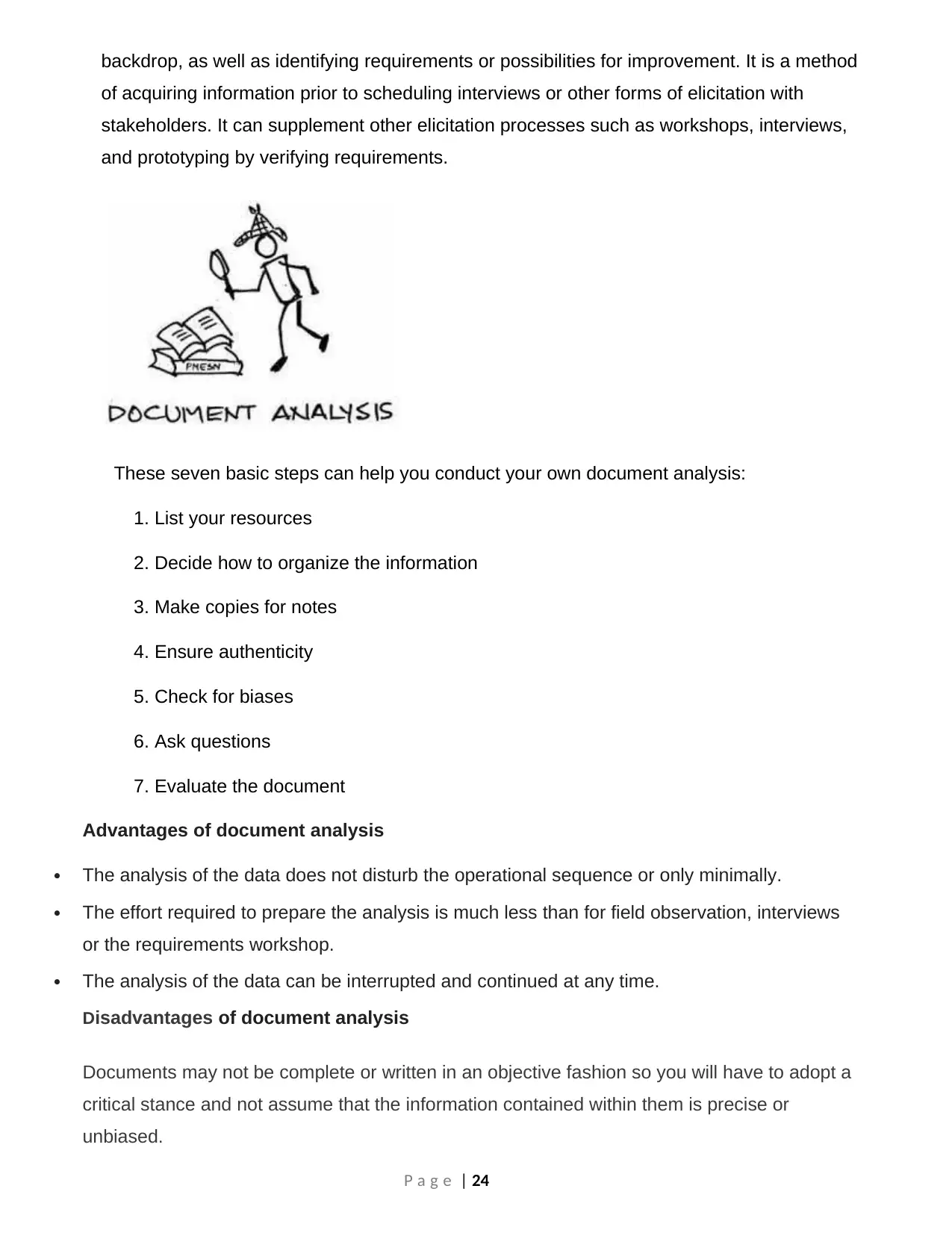
backdrop, as well as identifying requirements or possibilities for improvement. It is a method
of acquiring information prior to scheduling interviews or other forms of elicitation with
stakeholders. It can supplement other elicitation processes such as workshops, interviews,
and prototyping by verifying requirements.
These seven basic steps can help you conduct your own document analysis:
1. List your resources
2. Decide how to organize the information
3. Make copies for notes
4. Ensure authenticity
5. Check for biases
6. Ask questions
7. Evaluate the document
Advantages of document analysis
The analysis of the data does not disturb the operational sequence or only minimally.
The effort required to prepare the analysis is much less than for field observation, interviews
or the requirements workshop.
The analysis of the data can be interrupted and continued at any time.
Disadvantages of document analysis
Documents may not be complete or written in an objective fashion so you will have to adopt a
critical stance and not assume that the information contained within them is precise or
unbiased.
P a g e | 24
of acquiring information prior to scheduling interviews or other forms of elicitation with
stakeholders. It can supplement other elicitation processes such as workshops, interviews,
and prototyping by verifying requirements.
These seven basic steps can help you conduct your own document analysis:
1. List your resources
2. Decide how to organize the information
3. Make copies for notes
4. Ensure authenticity
5. Check for biases
6. Ask questions
7. Evaluate the document
Advantages of document analysis
The analysis of the data does not disturb the operational sequence or only minimally.
The effort required to prepare the analysis is much less than for field observation, interviews
or the requirements workshop.
The analysis of the data can be interrupted and continued at any time.
Disadvantages of document analysis
Documents may not be complete or written in an objective fashion so you will have to adopt a
critical stance and not assume that the information contained within them is precise or
unbiased.
P a g e | 24

The number of documents involved can lead to information overload. Which parts of which
document are most relevant to your question? Which is largely about the progress of your
project and the factors that have helped or hindered that progress?
5.6 Observation
Observation necessitates a business analyst going out and looking at the work, such as
watching the business processes within the scope of the project. By examining a user's work
environment, the elicitation technique observation is an excellent way of knowing how they
accomplish their job. This approach may be used to comprehend requirements and
contextualize them.
These approaches include observation techniques such as field observation, apprenticeship,
and contextual inquiry, as well as surveying techniques like as interviews, questionnaires, and
self-descriptions, as well as assisted techniques such as persona scenarios and use case
scenarios. Today, we'll look more closely at field observation, apprenticeship, and contextual
inquiry.
Advantages of Observation
The primary advantage of observation is its directness. We may capture data at the
point of occurrence. The observer is not required to question people about their
conduct or hear reports from others.
P a g e | 25
document are most relevant to your question? Which is largely about the progress of your
project and the factors that have helped or hindered that progress?
5.6 Observation
Observation necessitates a business analyst going out and looking at the work, such as
watching the business processes within the scope of the project. By examining a user's work
environment, the elicitation technique observation is an excellent way of knowing how they
accomplish their job. This approach may be used to comprehend requirements and
contextualize them.
These approaches include observation techniques such as field observation, apprenticeship,
and contextual inquiry, as well as surveying techniques like as interviews, questionnaires, and
self-descriptions, as well as assisted techniques such as persona scenarios and use case
scenarios. Today, we'll look more closely at field observation, apprenticeship, and contextual
inquiry.
Advantages of Observation
The primary advantage of observation is its directness. We may capture data at the
point of occurrence. The observer is not required to question people about their
conduct or hear reports from others.
P a g e | 25
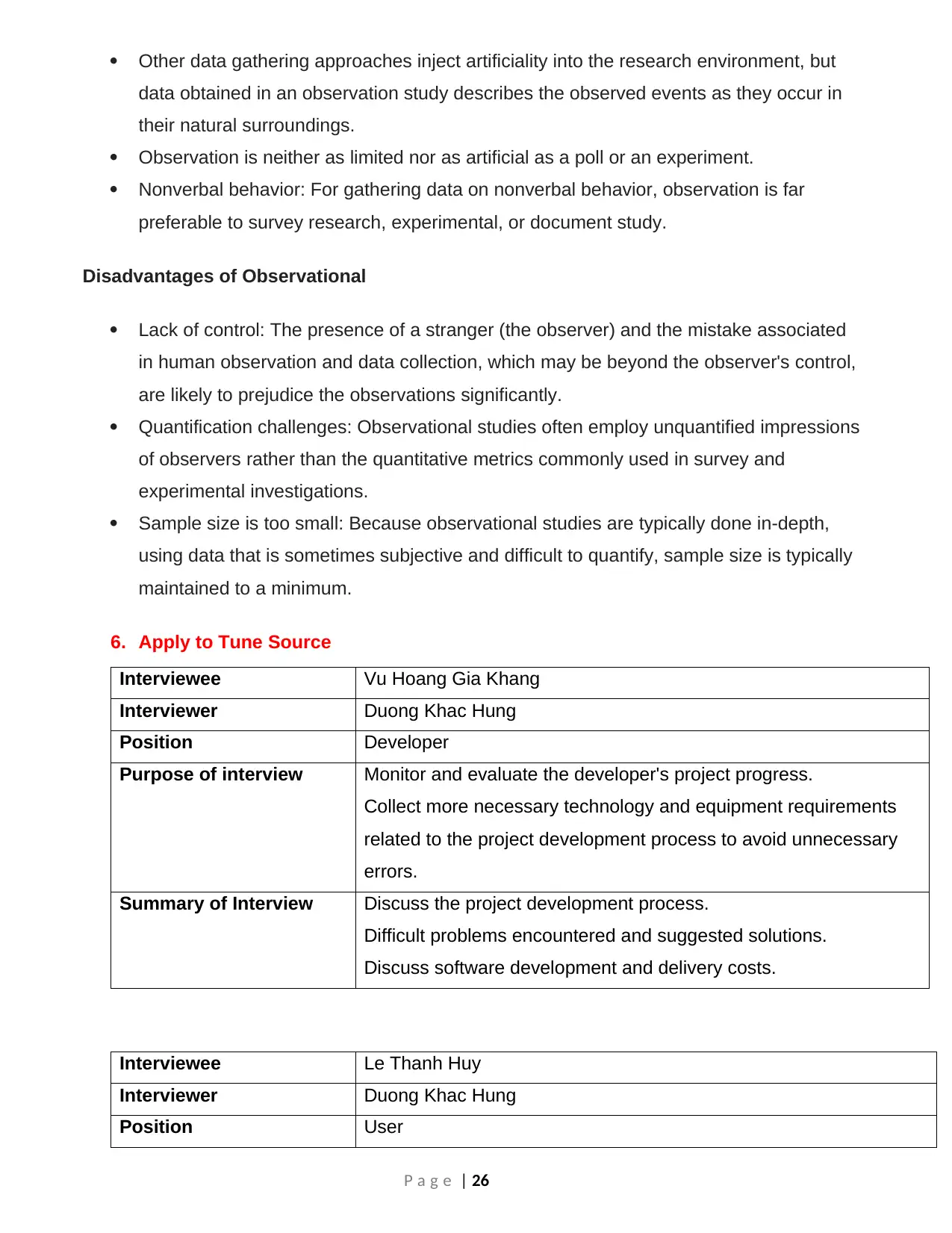
Other data gathering approaches inject artificiality into the research environment, but
data obtained in an observation study describes the observed events as they occur in
their natural surroundings.
Observation is neither as limited nor as artificial as a poll or an experiment.
Nonverbal behavior: For gathering data on nonverbal behavior, observation is far
preferable to survey research, experimental, or document study.
Disadvantages of Observational
Lack of control: The presence of a stranger (the observer) and the mistake associated
in human observation and data collection, which may be beyond the observer's control,
are likely to prejudice the observations significantly.
Quantification challenges: Observational studies often employ unquantified impressions
of observers rather than the quantitative metrics commonly used in survey and
experimental investigations.
Sample size is too small: Because observational studies are typically done in-depth,
using data that is sometimes subjective and difficult to quantify, sample size is typically
maintained to a minimum.
6. Apply to Tune Source
Interviewee Vu Hoang Gia Khang
Interviewer Duong Khac Hung
Position Developer
Purpose of interview Monitor and evaluate the developer's project progress.
Collect more necessary technology and equipment requirements
related to the project development process to avoid unnecessary
errors.
Summary of Interview Discuss the project development process.
Difficult problems encountered and suggested solutions.
Discuss software development and delivery costs.
Interviewee Le Thanh Huy
Interviewer Duong Khac Hung
Position User
P a g e | 26
data obtained in an observation study describes the observed events as they occur in
their natural surroundings.
Observation is neither as limited nor as artificial as a poll or an experiment.
Nonverbal behavior: For gathering data on nonverbal behavior, observation is far
preferable to survey research, experimental, or document study.
Disadvantages of Observational
Lack of control: The presence of a stranger (the observer) and the mistake associated
in human observation and data collection, which may be beyond the observer's control,
are likely to prejudice the observations significantly.
Quantification challenges: Observational studies often employ unquantified impressions
of observers rather than the quantitative metrics commonly used in survey and
experimental investigations.
Sample size is too small: Because observational studies are typically done in-depth,
using data that is sometimes subjective and difficult to quantify, sample size is typically
maintained to a minimum.
6. Apply to Tune Source
Interviewee Vu Hoang Gia Khang
Interviewer Duong Khac Hung
Position Developer
Purpose of interview Monitor and evaluate the developer's project progress.
Collect more necessary technology and equipment requirements
related to the project development process to avoid unnecessary
errors.
Summary of Interview Discuss the project development process.
Difficult problems encountered and suggested solutions.
Discuss software development and delivery costs.
Interviewee Le Thanh Huy
Interviewer Duong Khac Hung
Position User
P a g e | 26
Secure Best Marks with AI Grader
Need help grading? Try our AI Grader for instant feedback on your assignments.
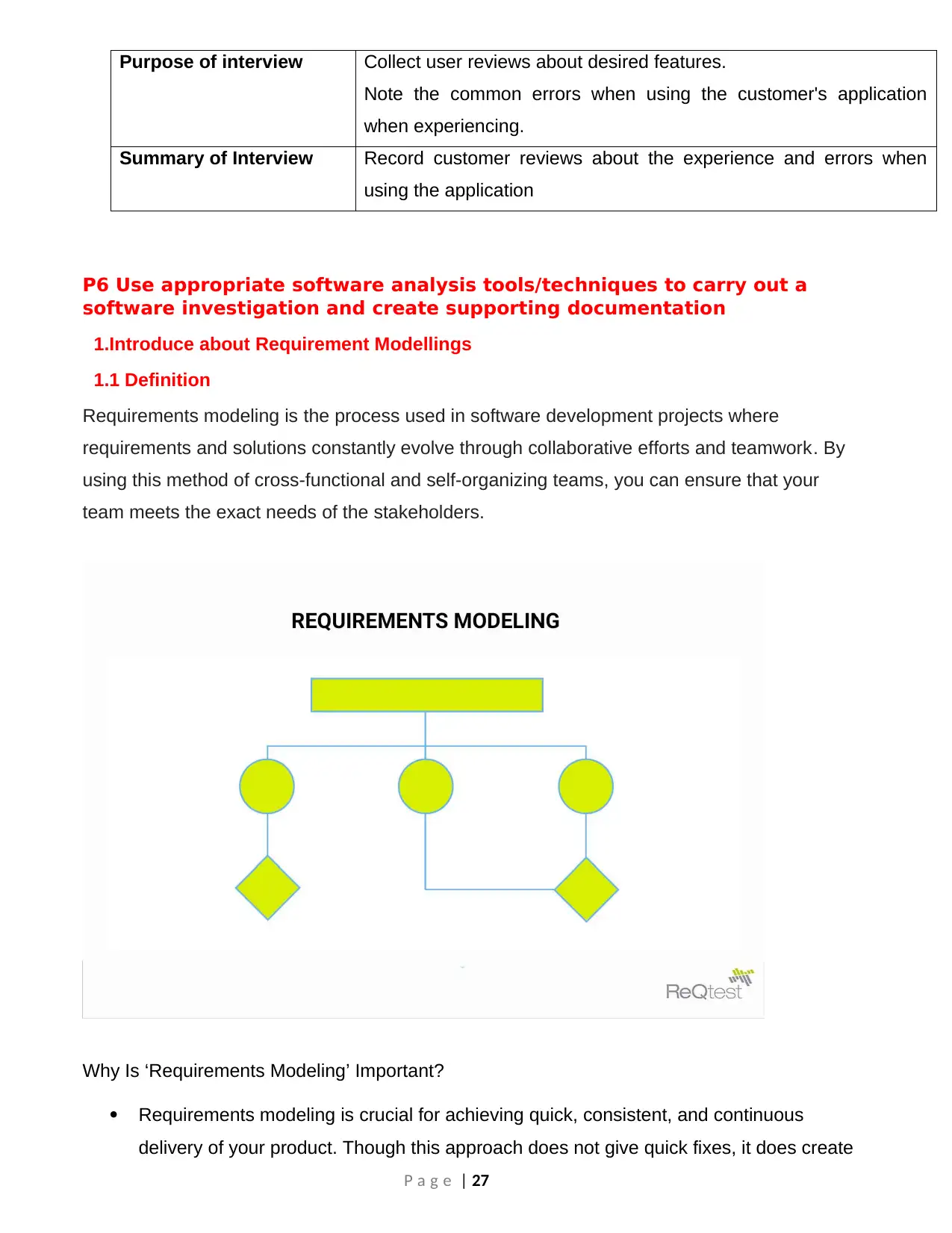
Purpose of interview Collect user reviews about desired features.
Note the common errors when using the customer's application
when experiencing.
Summary of Interview Record customer reviews about the experience and errors when
using the application
P6 Use appropriate software analysis tools/techniques to carry out a
software investigation and create supporting documentation
1.Introduce about Requirement Modellings
1.1 Definition
Requirements modeling is the process used in software development projects where
requirements and solutions constantly evolve through collaborative efforts and teamwork. By
using this method of cross-functional and self-organizing teams, you can ensure that your
team meets the exact needs of the stakeholders.
Why Is ‘Requirements Modeling’ Important?
Requirements modeling is crucial for achieving quick, consistent, and continuous
delivery of your product. Though this approach does not give quick fixes, it does create
P a g e | 27
Note the common errors when using the customer's application
when experiencing.
Summary of Interview Record customer reviews about the experience and errors when
using the application
P6 Use appropriate software analysis tools/techniques to carry out a
software investigation and create supporting documentation
1.Introduce about Requirement Modellings
1.1 Definition
Requirements modeling is the process used in software development projects where
requirements and solutions constantly evolve through collaborative efforts and teamwork. By
using this method of cross-functional and self-organizing teams, you can ensure that your
team meets the exact needs of the stakeholders.
Why Is ‘Requirements Modeling’ Important?
Requirements modeling is crucial for achieving quick, consistent, and continuous
delivery of your product. Though this approach does not give quick fixes, it does create
P a g e | 27

a solid foundation for the final result.
As a result, the development team will have a better grasp of the product and its
development procedures. As a result, it benefits both the developers and the clients if
they have any issues.
Using this method, you can present a precise strategy to both your project stakeholders
and clients. You can address any adjustments that are required to match their particular
criteria and specifications in this plan
By providing improved and timely feedback from the start of the project and throughout
the whole process, you will reduce the likelihood of roadblocks later on.
This is especially true when new team members are joined. These procedures will
provide new team members with an overview of the project from start to finish. This
enables new employees to better comprehend the system's iteration prioritizing..
2. Apply to Tune Source
2.1 ERD
P a g e | 28
As a result, the development team will have a better grasp of the product and its
development procedures. As a result, it benefits both the developers and the clients if
they have any issues.
Using this method, you can present a precise strategy to both your project stakeholders
and clients. You can address any adjustments that are required to match their particular
criteria and specifications in this plan
By providing improved and timely feedback from the start of the project and throughout
the whole process, you will reduce the likelihood of roadblocks later on.
This is especially true when new team members are joined. These procedures will
provide new team members with an overview of the project from start to finish. This
enables new employees to better comprehend the system's iteration prioritizing..
2. Apply to Tune Source
2.1 ERD
P a g e | 28
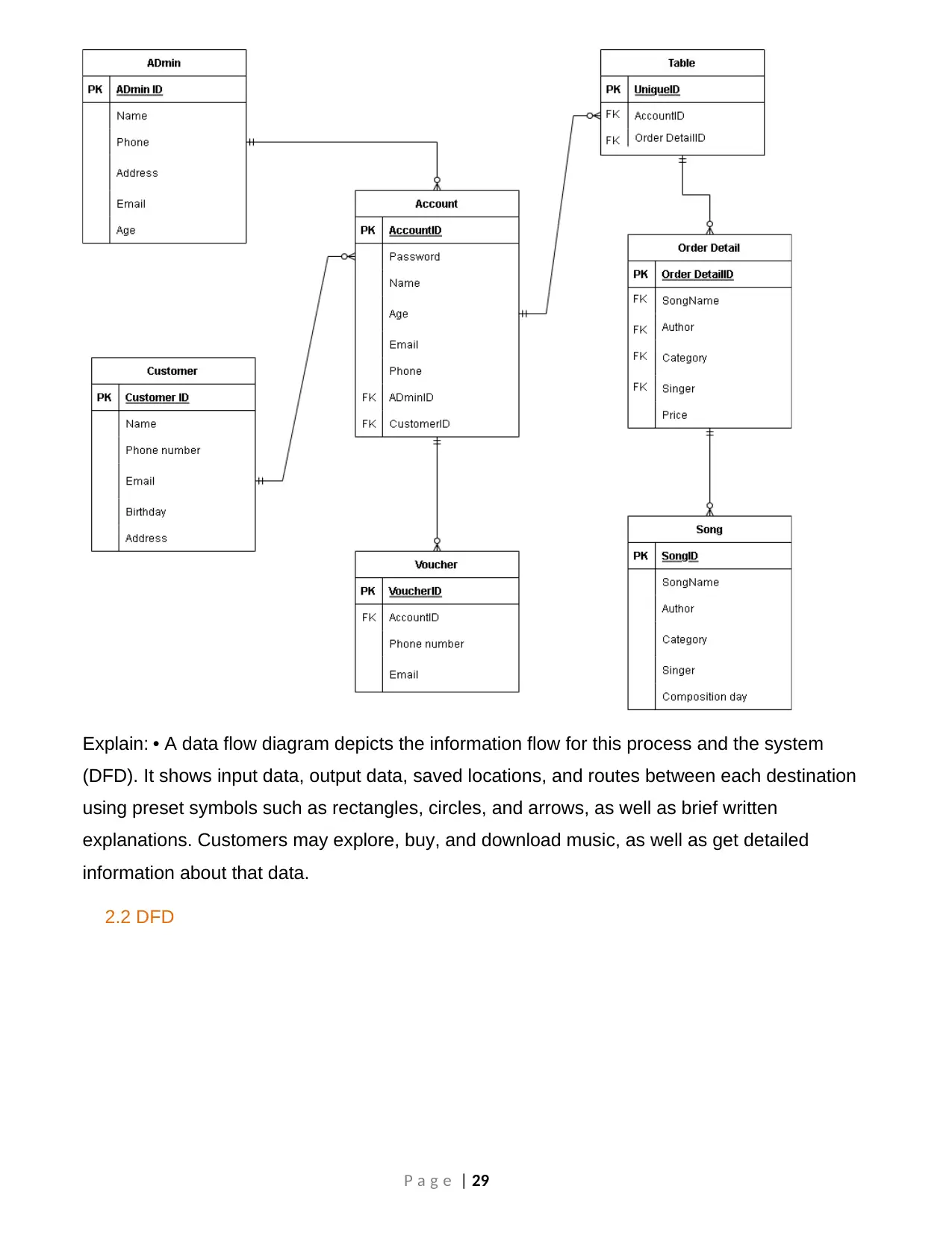
Explain: • A data flow diagram depicts the information flow for this process and the system
(DFD). It shows input data, output data, saved locations, and routes between each destination
using preset symbols such as rectangles, circles, and arrows, as well as brief written
explanations. Customers may explore, buy, and download music, as well as get detailed
information about that data.
2.2 DFD
P a g e | 29
(DFD). It shows input data, output data, saved locations, and routes between each destination
using preset symbols such as rectangles, circles, and arrows, as well as brief written
explanations. Customers may explore, buy, and download music, as well as get detailed
information about that data.
2.2 DFD
P a g e | 29
Paraphrase This Document
Need a fresh take? Get an instant paraphrase of this document with our AI Paraphraser
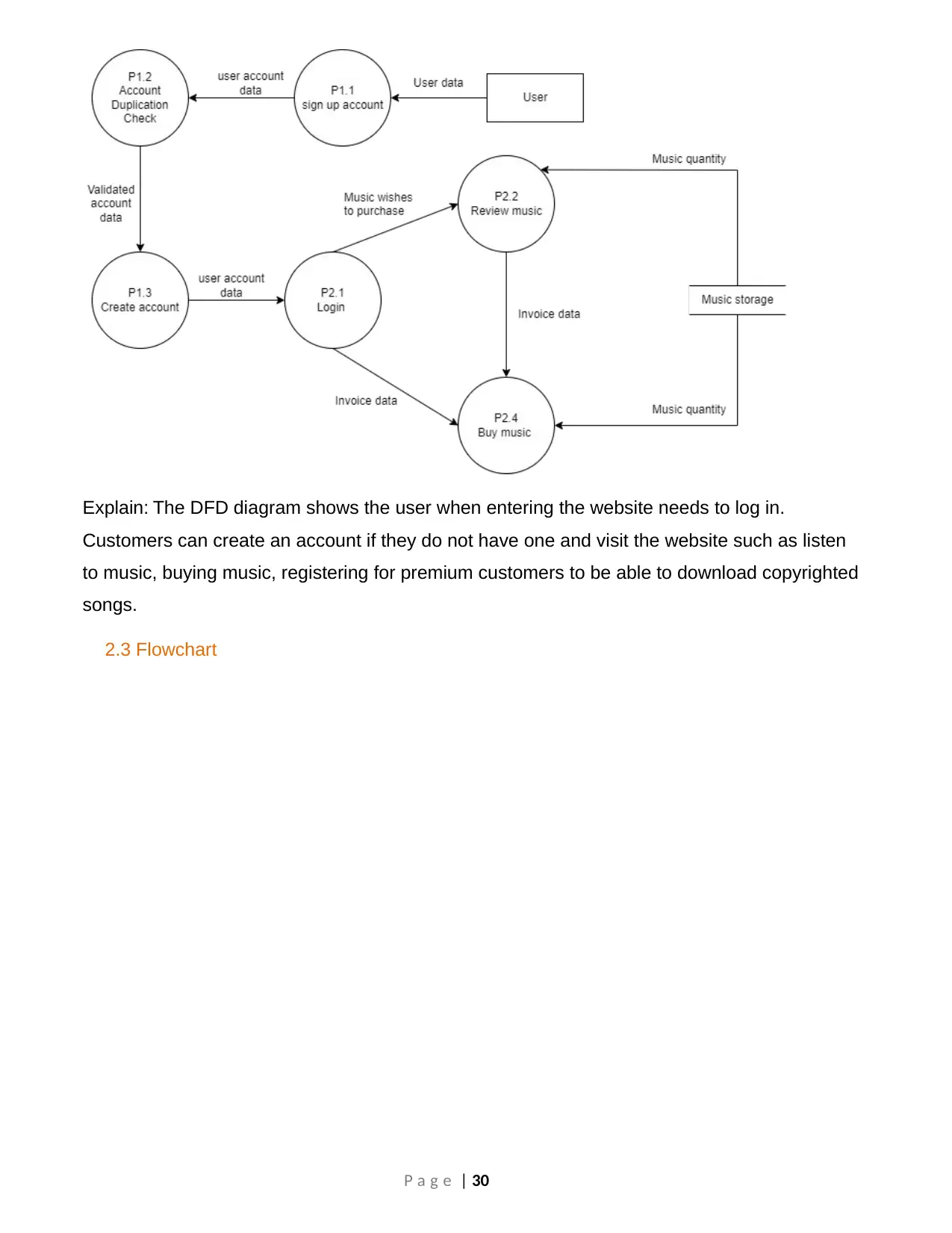
Explain: The DFD diagram shows the user when entering the website needs to log in.
Customers can create an account if they do not have one and visit the website such as listen
to music, buying music, registering for premium customers to be able to download copyrighted
songs.
2.3 Flowchart
P a g e | 30
Customers can create an account if they do not have one and visit the website such as listen
to music, buying music, registering for premium customers to be able to download copyrighted
songs.
2.3 Flowchart
P a g e | 30
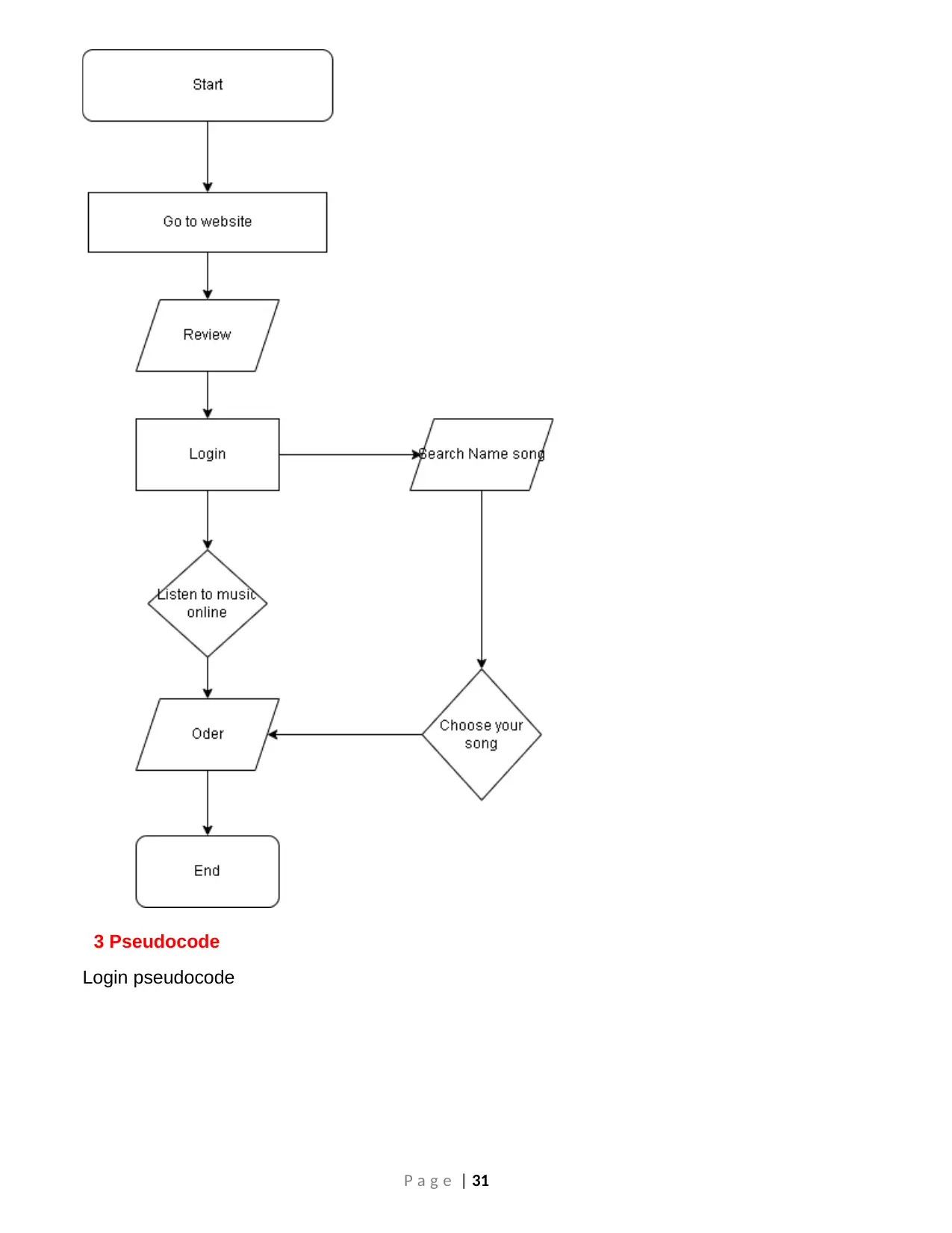
3 Pseudocode
Login pseudocode
P a g e | 31
Login pseudocode
P a g e | 31
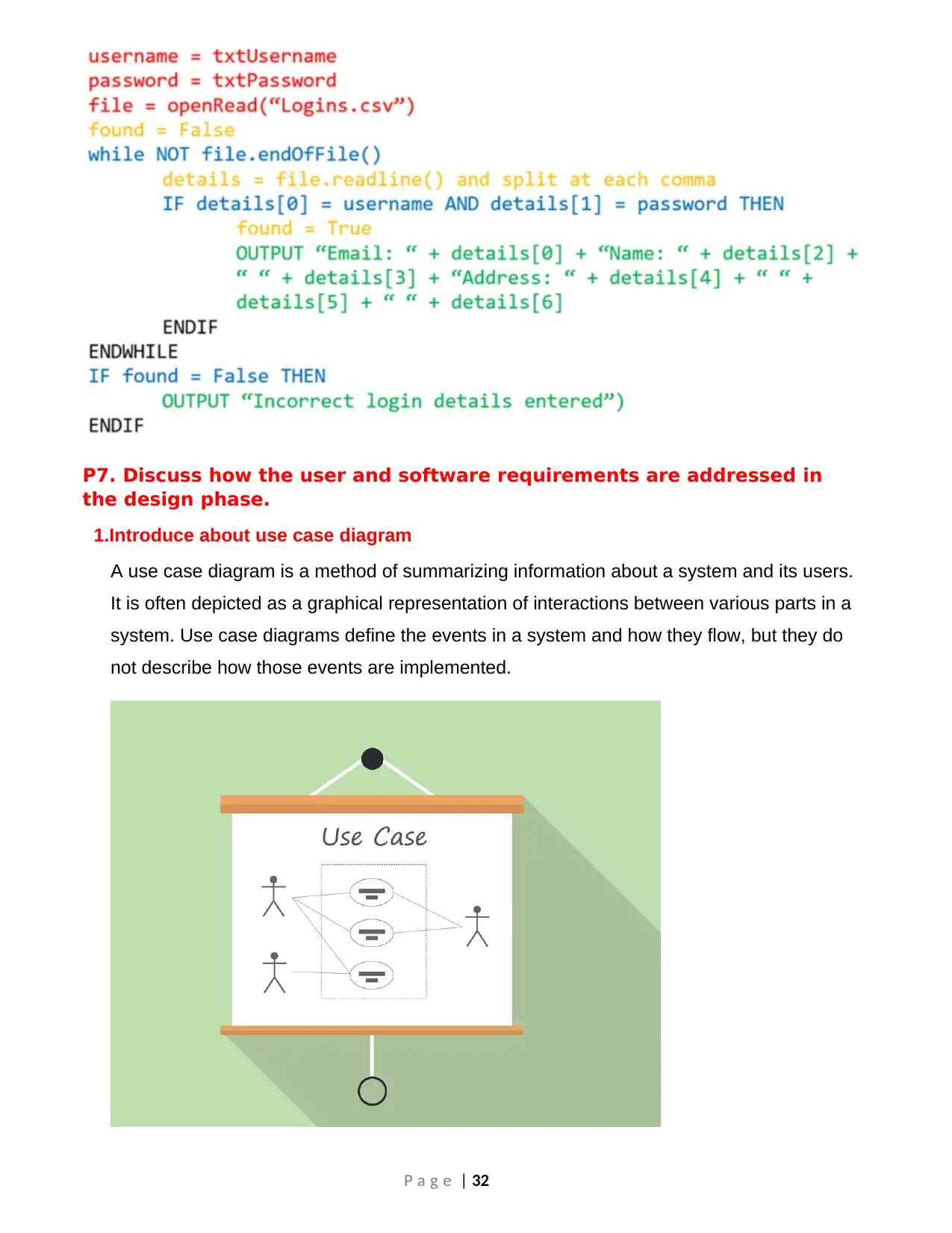
P7. Discuss how the user and software requirements are addressed in
the design phase.
1.Introduce about use case diagram
A use case diagram is a method of summarizing information about a system and its users.
It is often depicted as a graphical representation of interactions between various parts in a
system. Use case diagrams define the events in a system and how they flow, but they do
not describe how those events are implemented.
P a g e | 32
the design phase.
1.Introduce about use case diagram
A use case diagram is a method of summarizing information about a system and its users.
It is often depicted as a graphical representation of interactions between various parts in a
system. Use case diagrams define the events in a system and how they flow, but they do
not describe how those events are implemented.
P a g e | 32
Secure Best Marks with AI Grader
Need help grading? Try our AI Grader for instant feedback on your assignments.
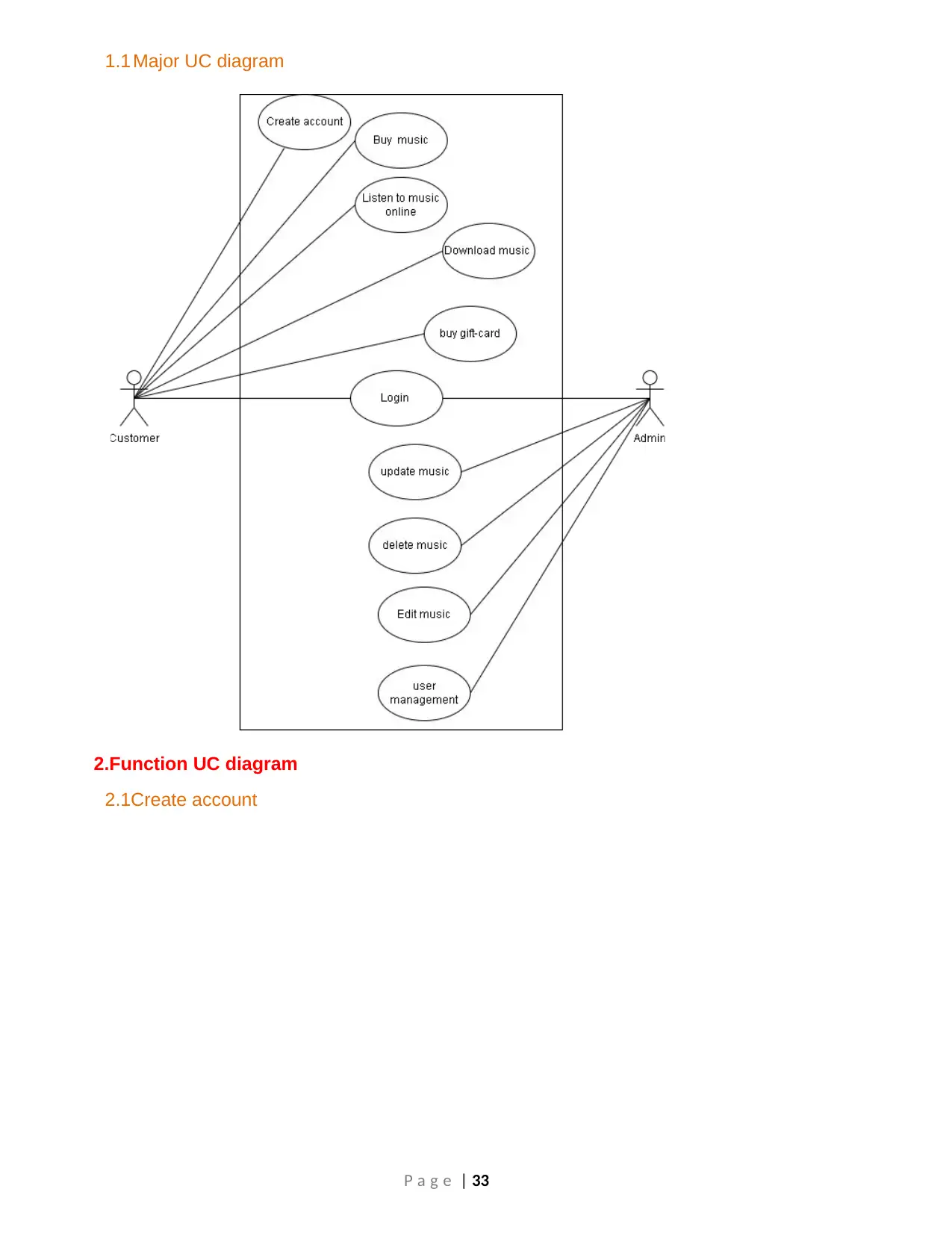
1.1 Major UC diagram
2.Function UC diagram
2.1Create account
P a g e | 33
2.Function UC diagram
2.1Create account
P a g e | 33
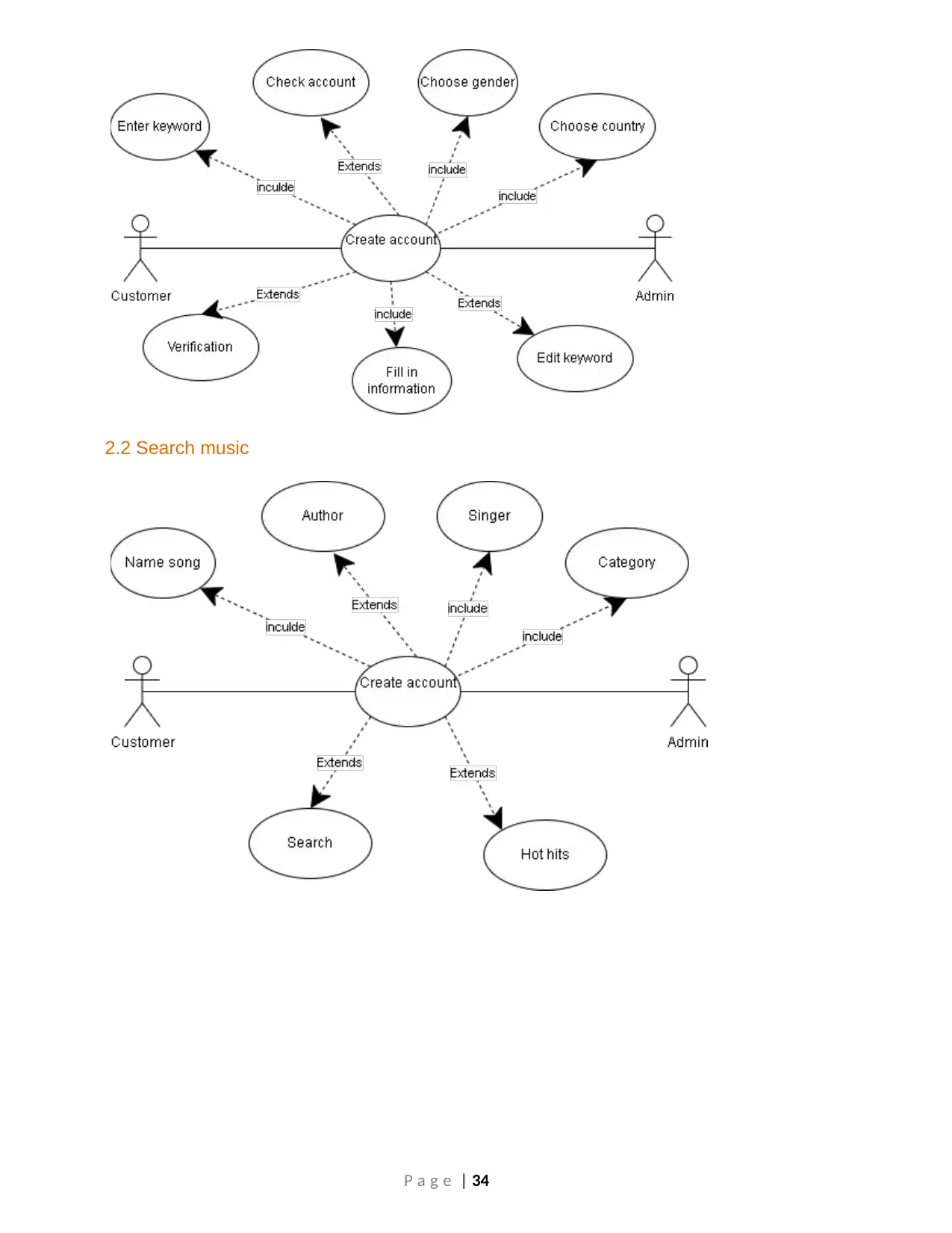
2.2 Search music
P a g e | 34
P a g e | 34

References
1. Anon., 2022. Software testing help. [Online] Available at:
https://www.softwaretestinghelp.com [Accessed 24 May 2022].
2. Sharma, L., 2021. Toolspa. [Online] Available at: www.toolsqa.com [Accessed 24 May
2022].
3. Pal.S.K, 2022 Geeksforgeeks. [online] .Available at:
https://www.geeksforgeeks.org/software-engineering-spiral-model/ [Accessed 24 May
2022].
4. Martin.M, 2022.Guru99. [online] .Available at: https://www.guru99.com/software-
engineering-prototyping-model.html [Accessed 24 May 2022].
5. Application Development (JAD) - Toolshero, J., 2022. Joint Application Development
(JAD) - Toolshero. [ONLINE] toolshero. Available at:
https://www.toolshero.com/information-technology/joint-application-development/.
[Accessed 22 June 2022].
P a g e | 35
1. Anon., 2022. Software testing help. [Online] Available at:
https://www.softwaretestinghelp.com [Accessed 24 May 2022].
2. Sharma, L., 2021. Toolspa. [Online] Available at: www.toolsqa.com [Accessed 24 May
2022].
3. Pal.S.K, 2022 Geeksforgeeks. [online] .Available at:
https://www.geeksforgeeks.org/software-engineering-spiral-model/ [Accessed 24 May
2022].
4. Martin.M, 2022.Guru99. [online] .Available at: https://www.guru99.com/software-
engineering-prototyping-model.html [Accessed 24 May 2022].
5. Application Development (JAD) - Toolshero, J., 2022. Joint Application Development
(JAD) - Toolshero. [ONLINE] toolshero. Available at:
https://www.toolshero.com/information-technology/joint-application-development/.
[Accessed 22 June 2022].
P a g e | 35
1 out of 37
Related Documents
Your All-in-One AI-Powered Toolkit for Academic Success.
+13062052269
info@desklib.com
Available 24*7 on WhatsApp / Email
![[object Object]](/_next/static/media/star-bottom.7253800d.svg)
Unlock your academic potential
© 2024 | Zucol Services PVT LTD | All rights reserved.





